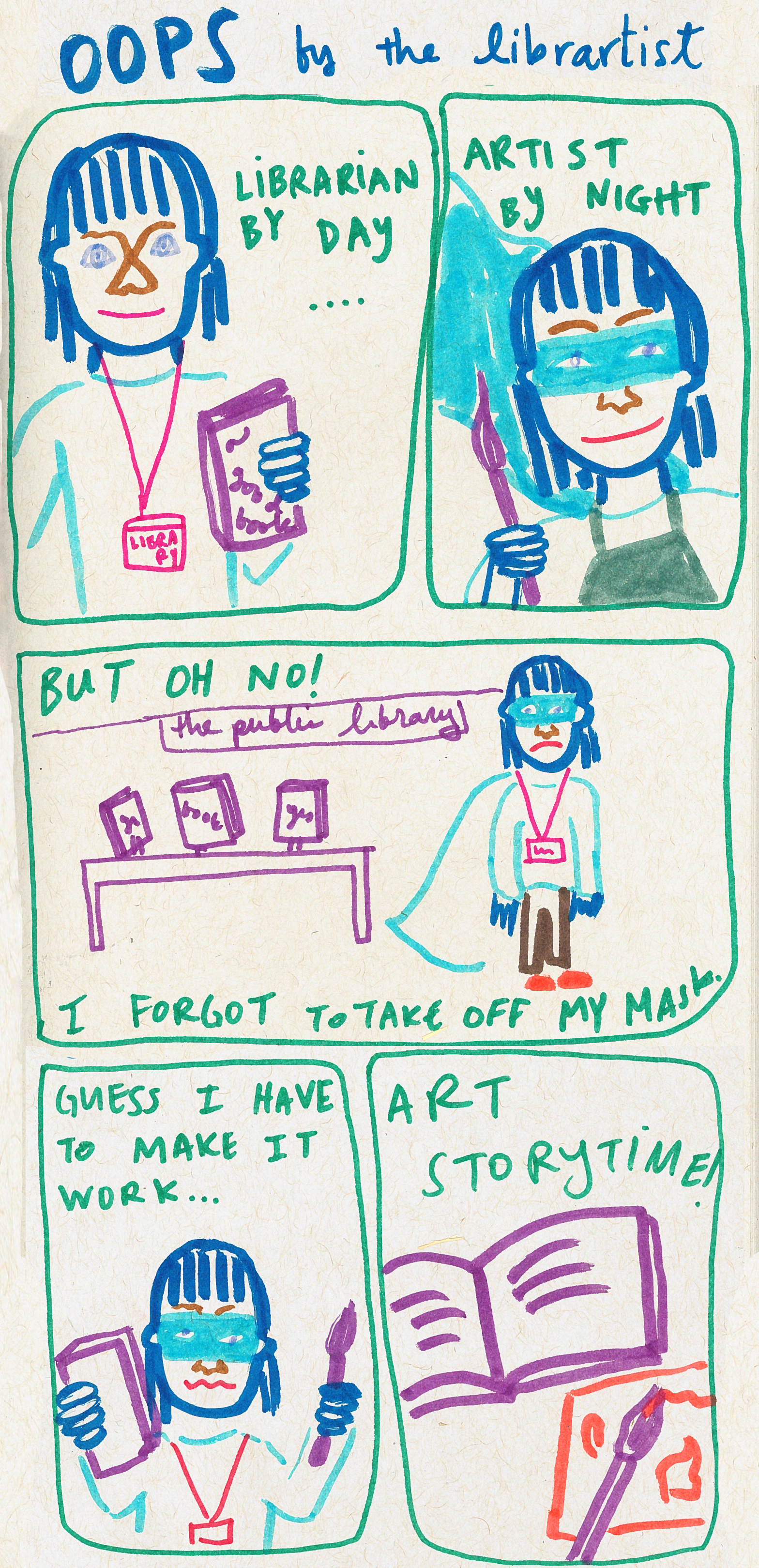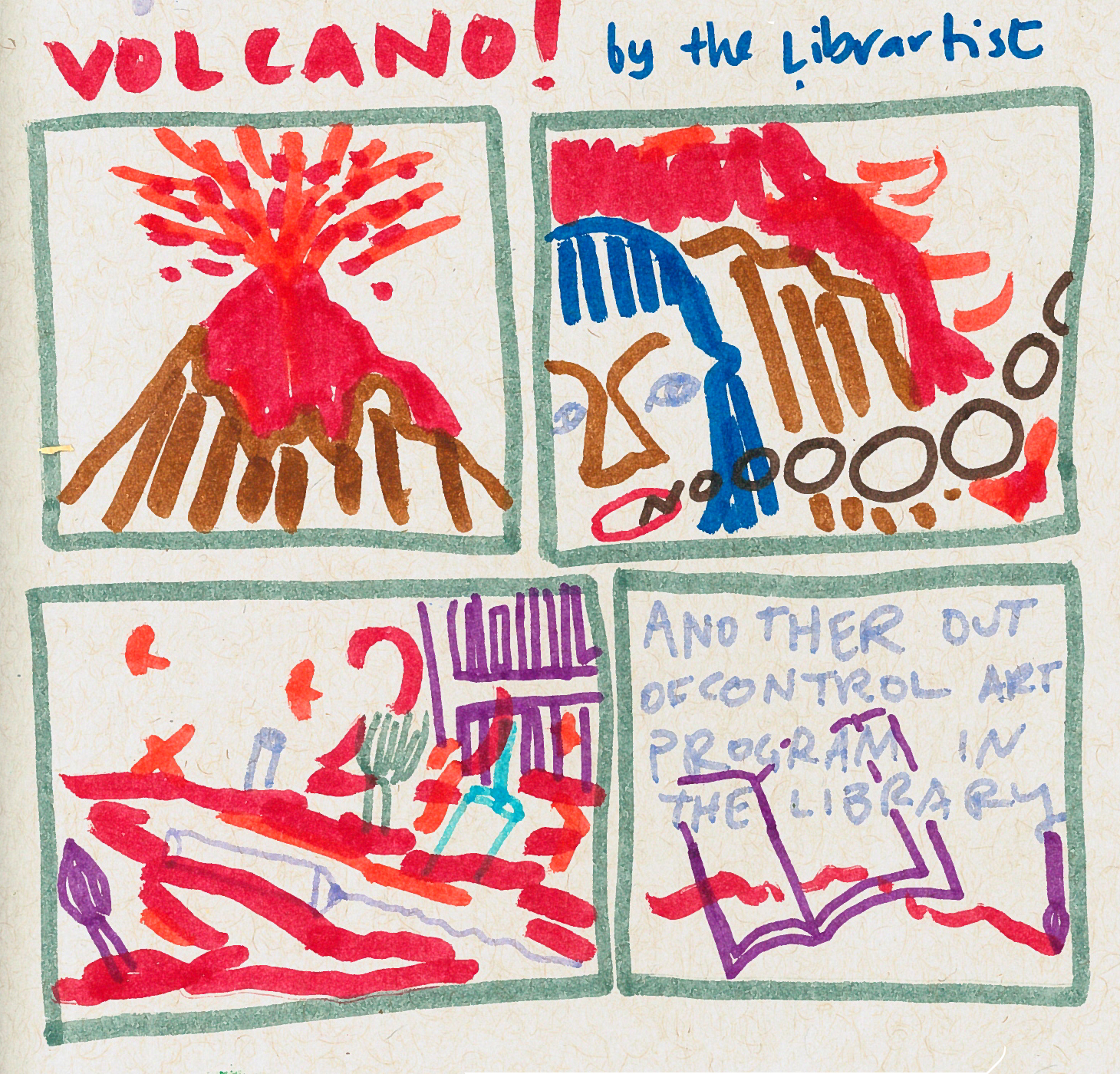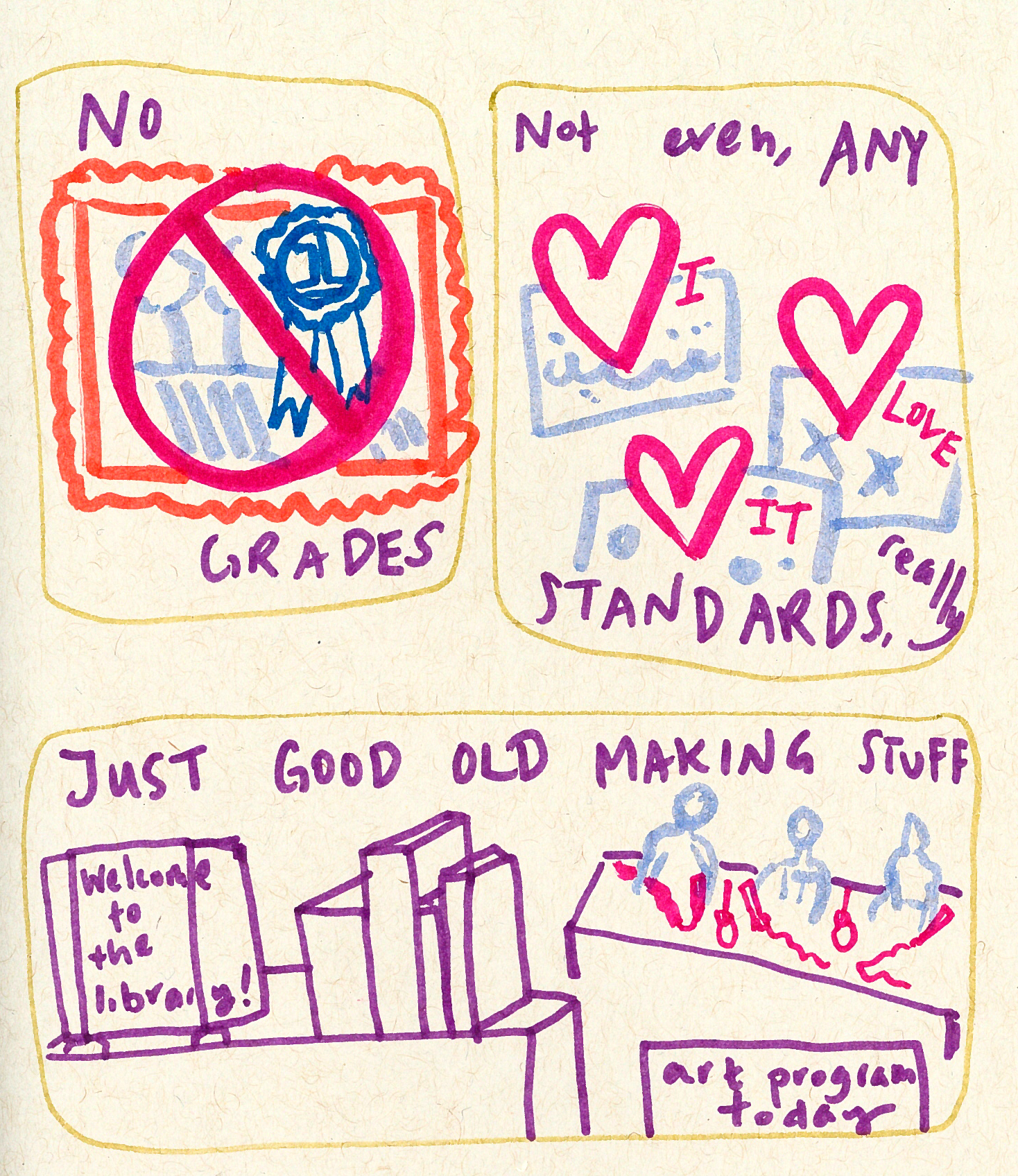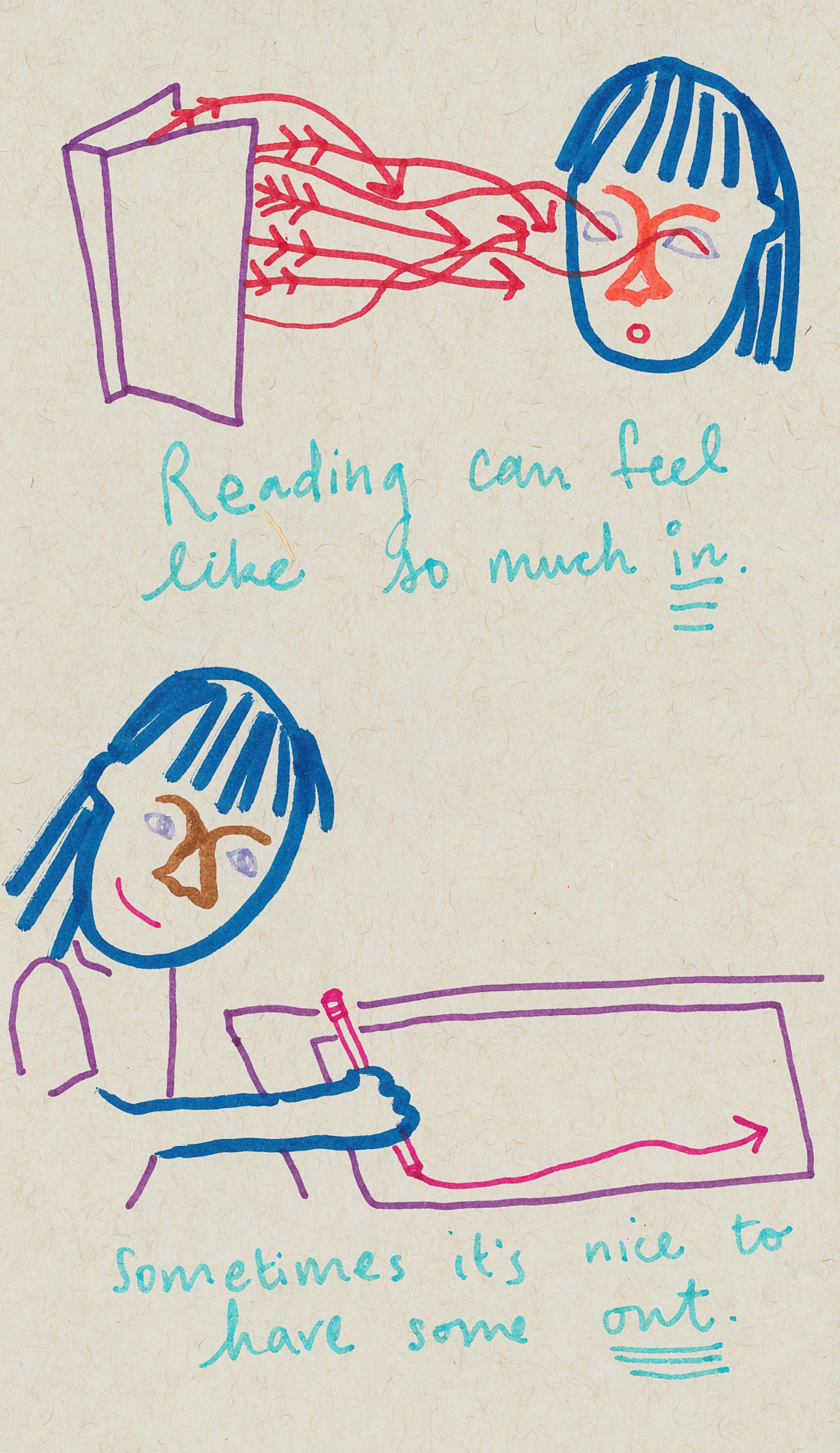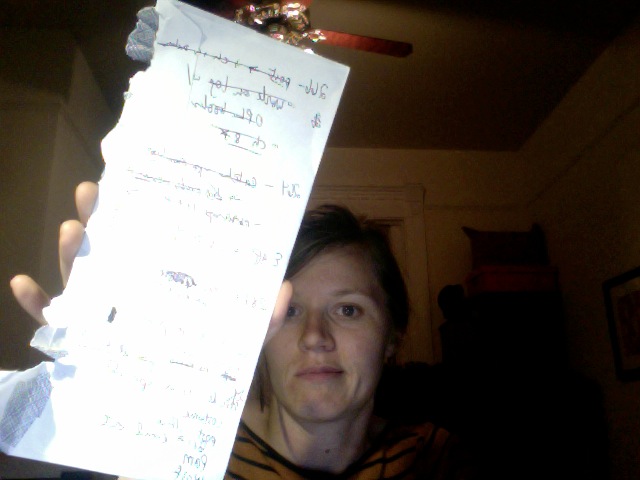Main menu
Bookworms wrapup!
Alas! My favorite class at the library has wrapped up. Bookworms, the drop-in storytime+art program for K-2nd graders is on break until August of next year. I’ve written about it before, but here are a couple more activities that we did.The format was always read a picture book, talk about an artist or medium/style, do an art program, and we would try to do a gallery walk – where we would hang the art and everyone would look at each others and people could talk about their work - as well (though kids got nervous sometimes that we would try to keep their work if we hung it up for a gallery walk)! I always printed out and hung up pictures of the artist or style so they could feel inspired.
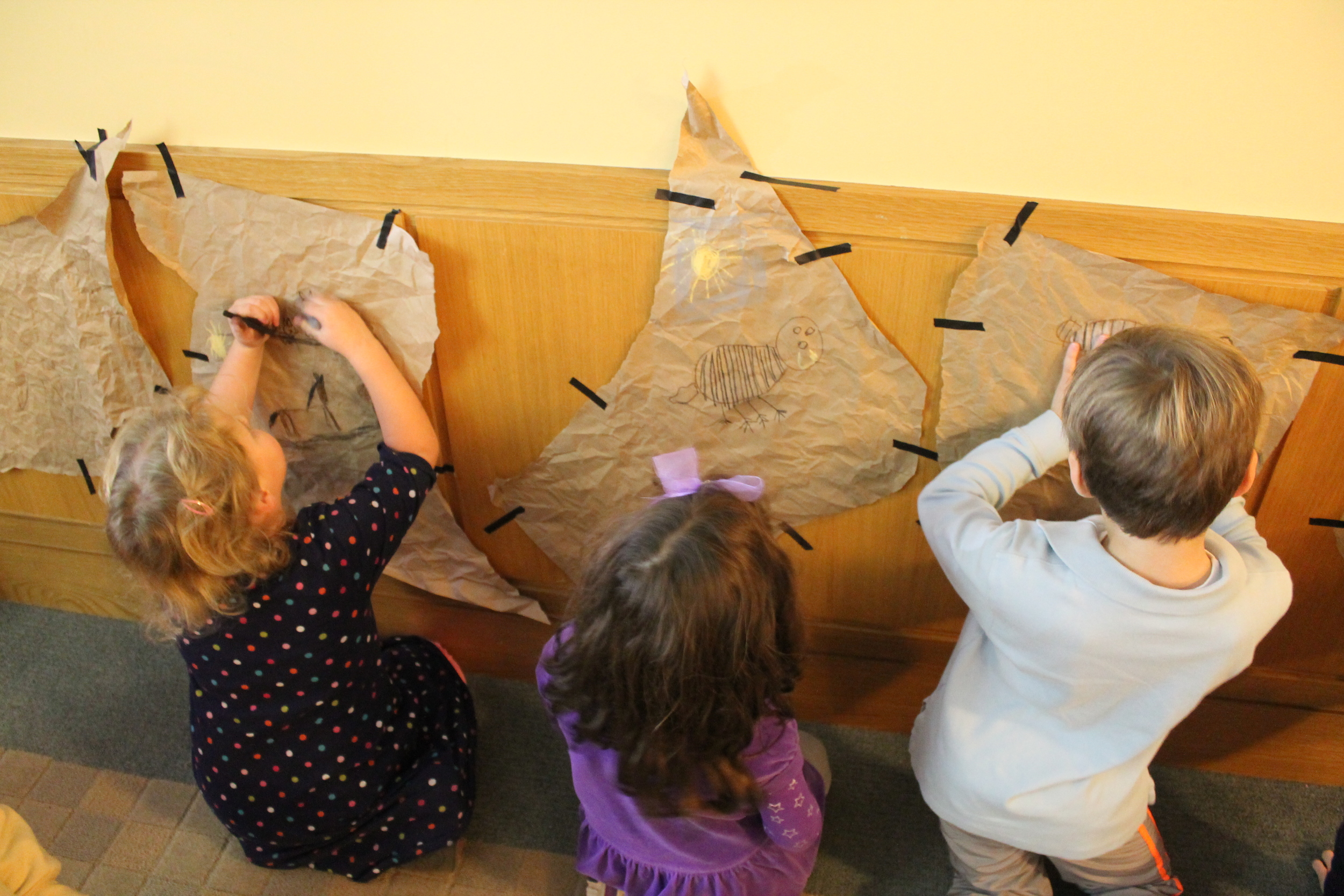 We started by reading The first drawing by Mordicai Gerstein
I kept the lights down low the whole time for this program to mimic being in a cave.
Opening framework: How long do you think people have been making art? We can’t really know! But some of the oldest art we’ve found is cave paintings, made on cave walls and ceilings, which date back to some 40,000 years ago in both Asia and Europe. The exact purpose of the Paleolithic cave paintings is not known.
Inspiring artists: slideshow of cave drawings - asking kids what do you see? What colors do you see? Why do you think artists used those colors?
Activity: I crinkled up brown butcher paper and hung it on the walls. Using pastels in earth tones, we created cave style drawings. I let the kids draw what they wanted to draw, but they made a lot of really interesting cave-like drawings.
We started by reading The first drawing by Mordicai Gerstein
I kept the lights down low the whole time for this program to mimic being in a cave.
Opening framework: How long do you think people have been making art? We can’t really know! But some of the oldest art we’ve found is cave paintings, made on cave walls and ceilings, which date back to some 40,000 years ago in both Asia and Europe. The exact purpose of the Paleolithic cave paintings is not known.
Inspiring artists: slideshow of cave drawings - asking kids what do you see? What colors do you see? Why do you think artists used those colors?
Activity: I crinkled up brown butcher paper and hung it on the walls. Using pastels in earth tones, we created cave style drawings. I let the kids draw what they wanted to draw, but they made a lot of really interesting cave-like drawings.
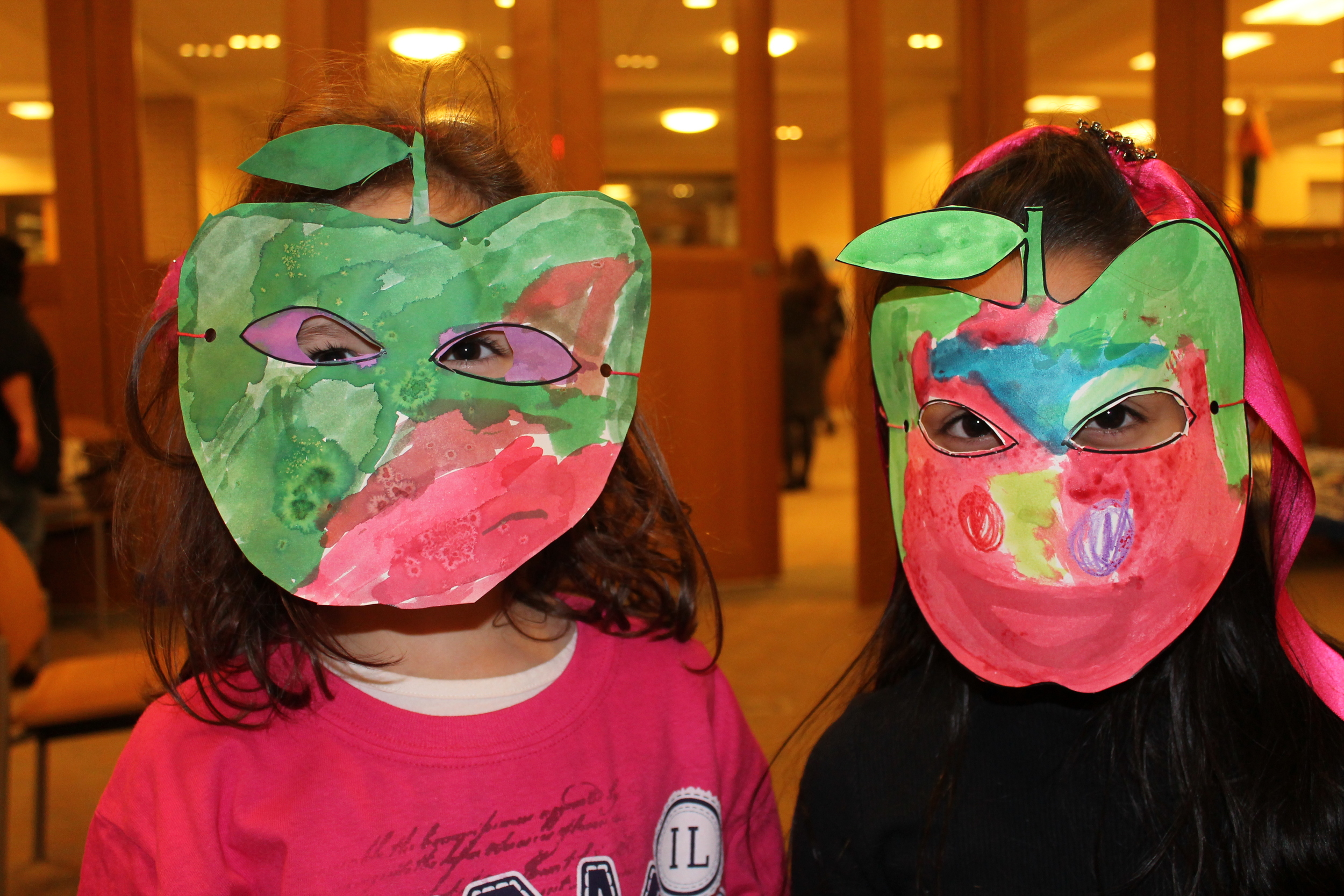 We started by reading Magritte's Marvelous Hat by DB Johnson
Opening framework: Today we’re going to talk about surrealism! Surrealism is a style of modern art in which images are based on fantasy and the world of dreams. It flourished in Europe from the mid-1920's to well after the end of World War II (1939-45). Surrealist artists tried to liberate these buried thoughts and feelings and use them as subjects for their art. They loved dreams, silly things out of place, and pushing the boundaries in art.
Inspiring art: Magritte! I printed out some pictures of the paintings referenced in the book.
Activity: We created masks using watercolors and salt! The idea was that when you wear these masks, things might look a little different when you look out from behind it – maybe even a little surreal. I cut out apple masks and then had them paint with watercolors and experiment with salt resist.
We started by reading Magritte's Marvelous Hat by DB Johnson
Opening framework: Today we’re going to talk about surrealism! Surrealism is a style of modern art in which images are based on fantasy and the world of dreams. It flourished in Europe from the mid-1920's to well after the end of World War II (1939-45). Surrealist artists tried to liberate these buried thoughts and feelings and use them as subjects for their art. They loved dreams, silly things out of place, and pushing the boundaries in art.
Inspiring art: Magritte! I printed out some pictures of the paintings referenced in the book.
Activity: We created masks using watercolors and salt! The idea was that when you wear these masks, things might look a little different when you look out from behind it – maybe even a little surreal. I cut out apple masks and then had them paint with watercolors and experiment with salt resist.
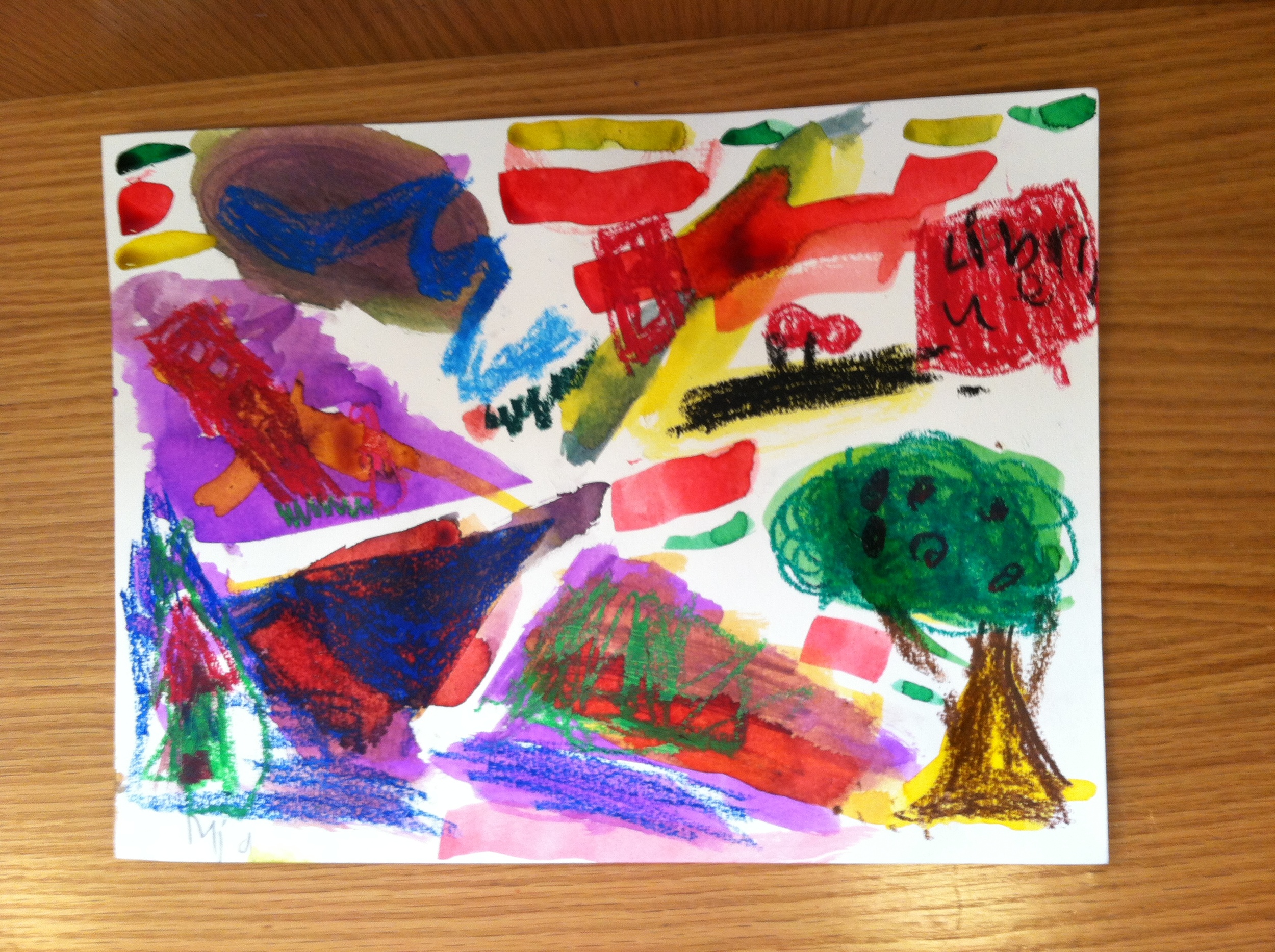 Young Frank, Architect by Frank Viva
Opening: We looked at city maps and talked about shapes we saw. Did anyone recognize the map of our town? What do we see in the maps? (lakes, streets, houses, trees, rivers, etc - write down on a big sheet)
Inspiring Artists: we looked at printed out pictures of the different towns from above and maps
Activity: With watercolor paper, we first did some taping with masking tape to make roads. Then we drew with oil pastels everything from trees to graveyards to houses. Then we painted over everything with liquid watercolors. Once the paintings were dry, we carefully peeled back the tape to reveal the white roads! When we did a gallery walk for this one everyone was very excited to talk about their towns.
Young Frank, Architect by Frank Viva
Opening: We looked at city maps and talked about shapes we saw. Did anyone recognize the map of our town? What do we see in the maps? (lakes, streets, houses, trees, rivers, etc - write down on a big sheet)
Inspiring Artists: we looked at printed out pictures of the different towns from above and maps
Activity: With watercolor paper, we first did some taping with masking tape to make roads. Then we drew with oil pastels everything from trees to graveyards to houses. Then we painted over everything with liquid watercolors. Once the paintings were dry, we carefully peeled back the tape to reveal the white roads! When we did a gallery walk for this one everyone was very excited to talk about their towns.
We started by reading The Iridescence of Birds by Patricia MacLachlan Opening framework - Today we’re going to paint with scissors, inspired by the artist Matisse! I showed a slideshow of his artwork – mostly the paper cutouts. I then also talked about shapes. I showed a picture of a pigeon (mentioned in the book) and we talked about what shapes we saw in the bird, and what kinds of shapes there are in the world. Geometric shapes — shapes that are commonly found in geometry, such as squares, triangles and rectangles Organic shapes — shapes that are commonly found in nature, usually with curved, irregular lines Positive shape — the shape itself Negative shape — the area around a shape or in between shapes, where you can see the background behind a shape Repeating shapes — the same shape, repeated multiple times, often in a grouping or making a path across the paper Stylized — an image which is simplified to the point of being abstract, but still carries a resemblance of it’s original form Activity: Everyone got scissors, iridescent paper, and construction paper – and even some fabric scraps (Matisse loved fabric). I printed out pictures of birds and arranged them for maximum enjoyment. Then they went wild! Only a couple people made birds – there were also some monsters, rugs (?!), and portraits.
We started by reading Shadow by Suzy Lee Opening framework: Shadows can be used to create art as well! Have you ever looked around and seen an interesting shadow? This was a wordless picture book, so we talked a lot during the reading of the story so that they could tell the story themselves. Inspiring artists: Kumi Yamashita, Indonesian Shadow Puppets Activity: We made foil puppets and shapes. I set up the room so there was a dark corner with bright lights to create stark shadows, where I helped them trace the shadow. Using oil pastels, they turned those shadow drawings into something cool!
Getting pumped about technology
I am definitely excited about all the new technologies that are accessible, inspire creativity, and are changing how we think about production and consumption. Sometimes, though, I feel less excited about teaching the technology know-how, and get more excited about the applications of technology. Of course when teaching it's important to learn the basics and introduce the main concepts, but my mind is always jumping ahead. 3D printers are totally cool, no doubt about it - I squealed with my first print. But there are so many questions about every technology that I think are important to ask that center around sustainability and transformation, especially as a youth librarian.
Sustainability
(or resilience, or whatever you want to call it)
I think this article does a pretty good job exploring issues behind 3D printing, one of the Maker movement’s biggest darlings. It asks the fundamental question: “We’re in a period where almost anyone has the tools to make almost anything – but are we making the right things? Or too many of the wrong ones?” Kids come in to our Makerspace and print little Minecraft figurines, or little elephants, or keychains for their teachers: all things that make them feel delighted to have printed themselves and gives them a certain amount of empowerment and wonder about the world. Hopefully they’re connecting that to more than just an easy way to get a plastic thing. Arieff says:
“A 3D printer consumes about 50 to 100 times more electrical energy than injection molding to make an item of the same weight. On top of that, the emissions from desktop 3D printers are similar to burning a cigarette or cooking on a gas or electric stove. And the material of choice for all this new stuff we’re clamoring to make is overwhelmingly plastic. In a sense, it’s a reverse environmental offset, counteracting recent legislation to reduce plastic use through grocery bag bans and packaging redesigns. While more people tote reuasable cloth bags to the supermarket, plastic is piling up in other domains, from TechShop to Target.”
I think that these concerns are valid. In a recent study from the Illinois Institute of Technology, results showed that “… caution should be used when operating some commercially available 3D printers in unvented or inadequately filtered indoor environments. Additionally, more controlled experiments should be conducted to more fundamentally evaluate aerosol emissions from a wider range of desktop 3D printers and feedstocks” (Stephens, Azimi, El Orch, & Ramos, 2013, p. 339). The researchers were concerned with the lack of data on the health hazards of 3D printers, in context of the hazards demonstrated by industrial 3D printers. Definitely something to think about. And as far as plastic goes, there is no lack of evidence that we are producing and trashing too much plastic. So are we teaching kids to create more plastic stuff that will become obsolete? Some sources point to 3D printing as a solution to environmental damage attributed to overseas shipping and cumbersome prototyping. But that is just about streamlining old manufacturing processes, not about rethinking how we create things in our world.
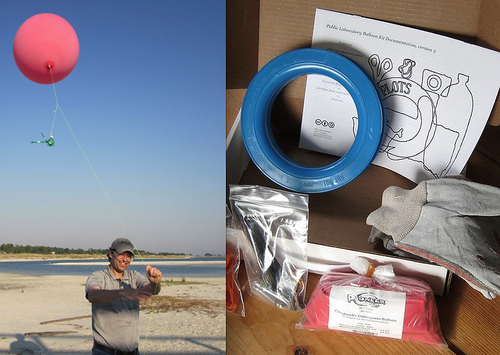
Obviously it’s not as black and white as that. There is a lot to be said for the importance of content creation in libraries, especially for young people, and 3D printers can be a great aspect of teaching that. As Nate Gass said, “[3D Printer] technology fits in about as neatly as book discussions, resume workshops, technology instruction, and children’s crafts- all standard practice in many public libraries. These types of services are not about content or information dissemination; they are about what you do with it. They involve some form of digesting, synthesizing, and creating, all within a community context.” The key words in that I think are community context: how can we empower kids to think about making beyond just designing products or printing a new toy? At my library, we've done some solution-based 3D printing classes, asking kids to think how can we solve problems using our prints.
An exciting application of technology that is about the environment and collaborative technology is Public Lab, which works to “build and inspire a community of DIY activists and explorers using simple tools to build a growing body of data about our local environments.” They create kits to gather big and small data on the environment, such as testing water, indoor air quality monitoring, detecting pollutants through spectrometers, and environmental mapping with balloons. This project seems like an incredible way to involve people in science and in a collaborative community context for science and environmentalism. Printing supplies on a 3D printer for engaging in a public science project like this seems like an excellent use of a Makerspace.
Another great idea is the iFixit website, which is working to battle obsolescence by creating repair guides to everything. This could be a great educational program that focuses on technology skills and rethinking our consumer products. It is empowering to be able to fix your own stuff, and reduces waste.
Transformation Another aspect of technology that interests me is the idea of transformation: social, personal, and political. If the only framing of transformation we have is disruption - ie Amazon introducing 2-day shipping, or Facebook creating new ways to collect information on consumers, etc - then I’m the opposite of interested. However, technology, like many other tools (I still believe a lot in the power of handmade art), has the power to transform how we interact with the world or deal with problems.
Something I found recently that was exciting was the wearable tech hoodie, developed by Iltimas Doha--Eyebeam Student Resident at Eyebeam Atelier.
 “In New York City, 9 out of 10 people stopped by police have been innocent. 50% of those stopped are youth (aged 14-24).
Smartphone apps are excellent ways to record and document these incidences. But what if you’re too scared or vulnerable to pull out your phone?
It’s time to empower youth with the modern tools to protect themselves against profiling and harrassment by law enforcement. Iltimas Doha--Eyebeam Student Resident--wants to make this happen!
Though the stop-and-frisk tactic is diminishing as a tool used by the NYPD, and crime rates are down this year across NYC, youth of color are still being victimized and criminalized. We can’t have more youth end up like Mike Brown or Oscar Grant.
“Perhaps the most traumatizing part is the point of realization that you have been totally disempowered. That the officer who stopped you can literally do whatever they’d like, right up to putting their hands on their sidearm, and all you do is hope and pray that this time you look light enough, look mature enough, look innocent enough, that they won't touch you. Because that’s all can be done; there is no tool or tactic you can reasonably use in these situations,” says Iltimas.
Iltimas needs your help to create a hoodie embedded with stealth technology like sensors and GPS that will record and transmit data for your own protection.”
Wearable tech as itself - a fun way to light up your outfit, A cute yarn flower that glows - has a lot of cool factor. But an application like Iltimas’ is totally exciting. And a library space that not only offers classes on how to do these things, but showcases exciting applications of tech, is an important community resource.
“In New York City, 9 out of 10 people stopped by police have been innocent. 50% of those stopped are youth (aged 14-24).
Smartphone apps are excellent ways to record and document these incidences. But what if you’re too scared or vulnerable to pull out your phone?
It’s time to empower youth with the modern tools to protect themselves against profiling and harrassment by law enforcement. Iltimas Doha--Eyebeam Student Resident--wants to make this happen!
Though the stop-and-frisk tactic is diminishing as a tool used by the NYPD, and crime rates are down this year across NYC, youth of color are still being victimized and criminalized. We can’t have more youth end up like Mike Brown or Oscar Grant.
“Perhaps the most traumatizing part is the point of realization that you have been totally disempowered. That the officer who stopped you can literally do whatever they’d like, right up to putting their hands on their sidearm, and all you do is hope and pray that this time you look light enough, look mature enough, look innocent enough, that they won't touch you. Because that’s all can be done; there is no tool or tactic you can reasonably use in these situations,” says Iltimas.
Iltimas needs your help to create a hoodie embedded with stealth technology like sensors and GPS that will record and transmit data for your own protection.”
Wearable tech as itself - a fun way to light up your outfit, A cute yarn flower that glows - has a lot of cool factor. But an application like Iltimas’ is totally exciting. And a library space that not only offers classes on how to do these things, but showcases exciting applications of tech, is an important community resource.
Next steps As a children’s librarian, the question is always how can empower children to be part of sustainable or transformative processes. Giving children the experience of being part of something larger than themselves, sharing their projects and ideas with the world, and thinking about solutions and projects that contribute to world issues, can be scaled to many different ages and programs.
Sources cited in depth
Arieff, A. (n.d.). Yes We Can. But Should We? The unintended consequences of the maker movement [Web log post]. Medium. Retrieved from https://medium.com/re-form/just-because-you-can-doesnt-mean-you-should-252fdbcf76c8
Gass, N. (2013, January 30). Do 3D Printers belong in libraries? [Web log post]. Nate’s Broadcast. Retrieved from http://www.natesbroadcast.com/journal/do-3d-printers-belong-in-libraries-a-defense
Royte, E. (2013, May). What Lies Ahead for 3-D Printing? The new technology promises a factory in every home—and a whole lot more. Smithsonian Magazine online. Retrieved from http://www.smithsonianmag.com/science-nature/what-lies-ahead-for-3-d-printing-37498558/?all
Stephens, B., Azimi, P., El Orch, Z., & Ramos, T. (2013). Ultrafine particle emissions from desktop 3D printers. Atmospheric Environment, 79334-339. doi:10.1016/j.atmosenv.2013.06.050
*post updated October 28, 2014
Making open-ended arts activities
I get to do an insanely fun program every Thursday at Darien called Bookworms, where we read a story and then make art together inspired by the book. Originally, I was trying to do a formal art class where we talk about different art theories and concepts. Of course this is a silly idea with ages 5-7, after school, and with my goals of encouraging informal arts education. Also, the kids are just so insanely creative that I didn’t want to squash it at all. So instead, we’re doing activities that are open ended, inspire creativity and joy, and encourage those minds to imagine. I love this quote from New Creativity Paradigms: Arts Learning in the Digital Age by Kylie Peppler: “Art with a capital A usually refers to those genres and works at the center of formal arts curricula, embodiments of highly valued creative practices, pedagogies and movements transmitted culturally between generations. Art with a lower case a, on the other hand, includes modes of expression that, while meaningful to its creator, can fall outside of the aesthetic perimeter of formal institutions" (2014, p. 5). This is what really makes me excited - toggling between those two things with kids who come into the class or space because they want to be there, and offering an open and engaging space.
Here's a couple of things we've done so far:
We started by readingIsh by Peter H. Reynolds Opening framework: We all can use similar materials in different ways! What happens when we all have the same exact materials? Artist to inspire: Franz Marc - German painter, born in 1880 - painted crazy colored animals! Took something that existed -ie cow, horse, and made it his own. RULES OF BOOKWORMS - there’s no right way, encourage each other, do we have any others? Activity: give everyone same supplies - scissors, glue, and paper cut into circles, squares, and triangles. Have them go crazy (this was also an assessment activity to see how their cutting/glueing skills were). Gallery walk: Put them out and have a walk through, talking about differences and similarities, letting kids talk about their artwork.
We started by reading Draw me a star by Eric Carle
Opening framework: Today we're going to be inspired by a shape, and by our own imaginations and wishes. Post reading: i like this book because sometimes when you’re drawing or creating, something tells you in the drawing what to draw next. has anyone ever experienced that?
Inspiring artist: Starry night, Egyptian tiles, Fred Tomaselli
Activity: Using contact paper, we made a "Wish portrait" - a collage using sparkles and drawings that then you could hang in the window.
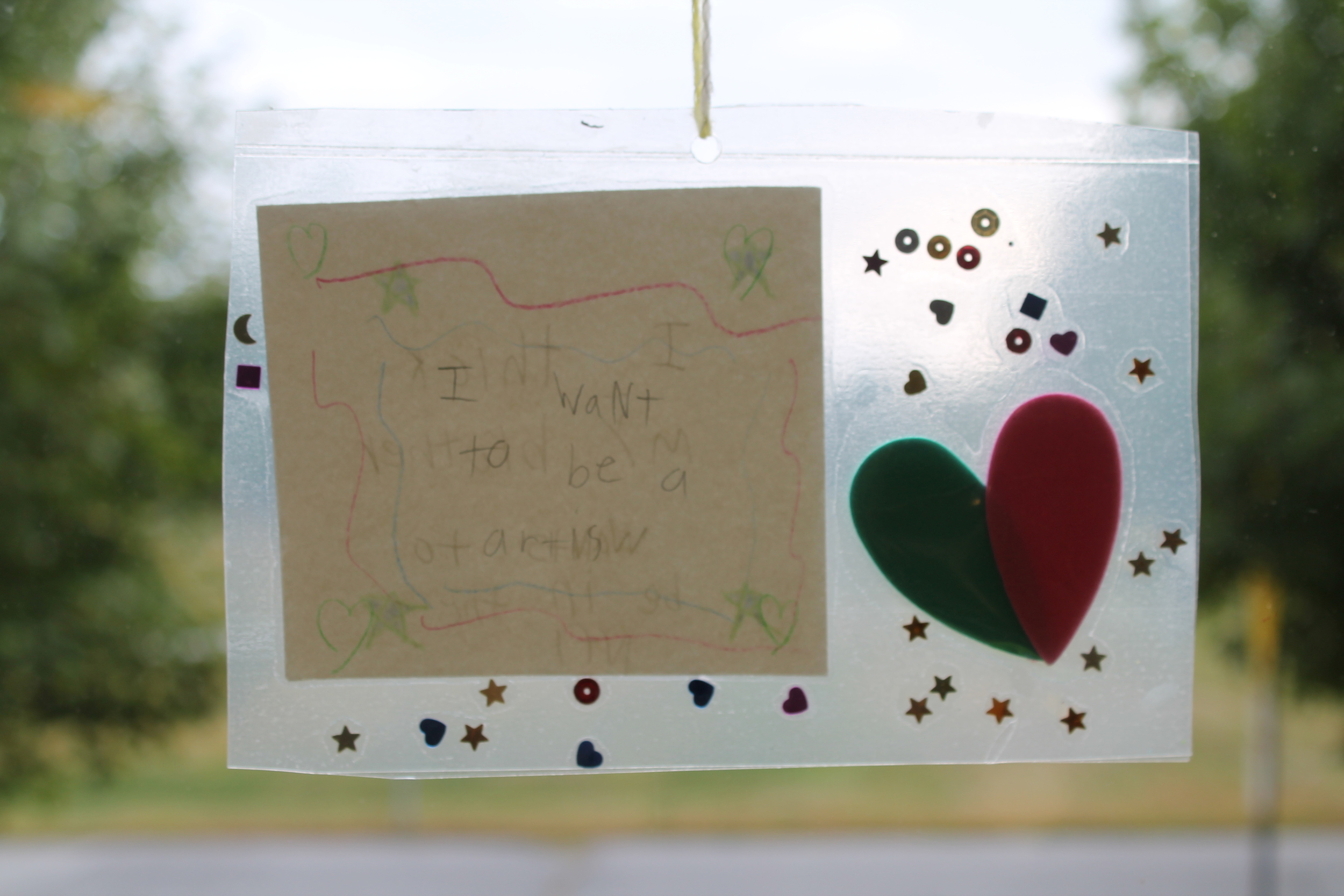
Sky Color by Peter H. Reynolds Opening: We made a list of what color an apple is, or the sky, or a tree. Then we looked at artists to inspire: Alice Neel, Van Gogh, Anders Zorn, and Mary Cassatt and their renditions of sky, water, faces, and grapes, and talked about what colors we saw. Activity: I bought a bunch of fruit and had them draw them with oil pastels, asking them to draw one with the colors they actually saw and then one with whatever colors they wanted. Then we did a gallery walk!
It's been a great time! I have heard from people that their kids are losing their love of art that they cultivated in preschool to rote coloring book pages and scripted crafts, and it feels like something I can do in Darien that is really purposeful and necessary. I was so inspired during the zine-making workshop to see how excited they were to write stories, and even had a kid who wasn’t in the class ask about it and spend an hour writing his own story.
Similarly, during a Book Group discussion about Frankie Pickle and the Pinewood 300, I had planned for the kids to do little races using a pingpong ball on a pegboard with a course they created made from pipecleaners. But they didn't even want to race, they just wanted to have fun dropping the ball down the course at different angles! So much joy to be had from spontaneous, open activities.
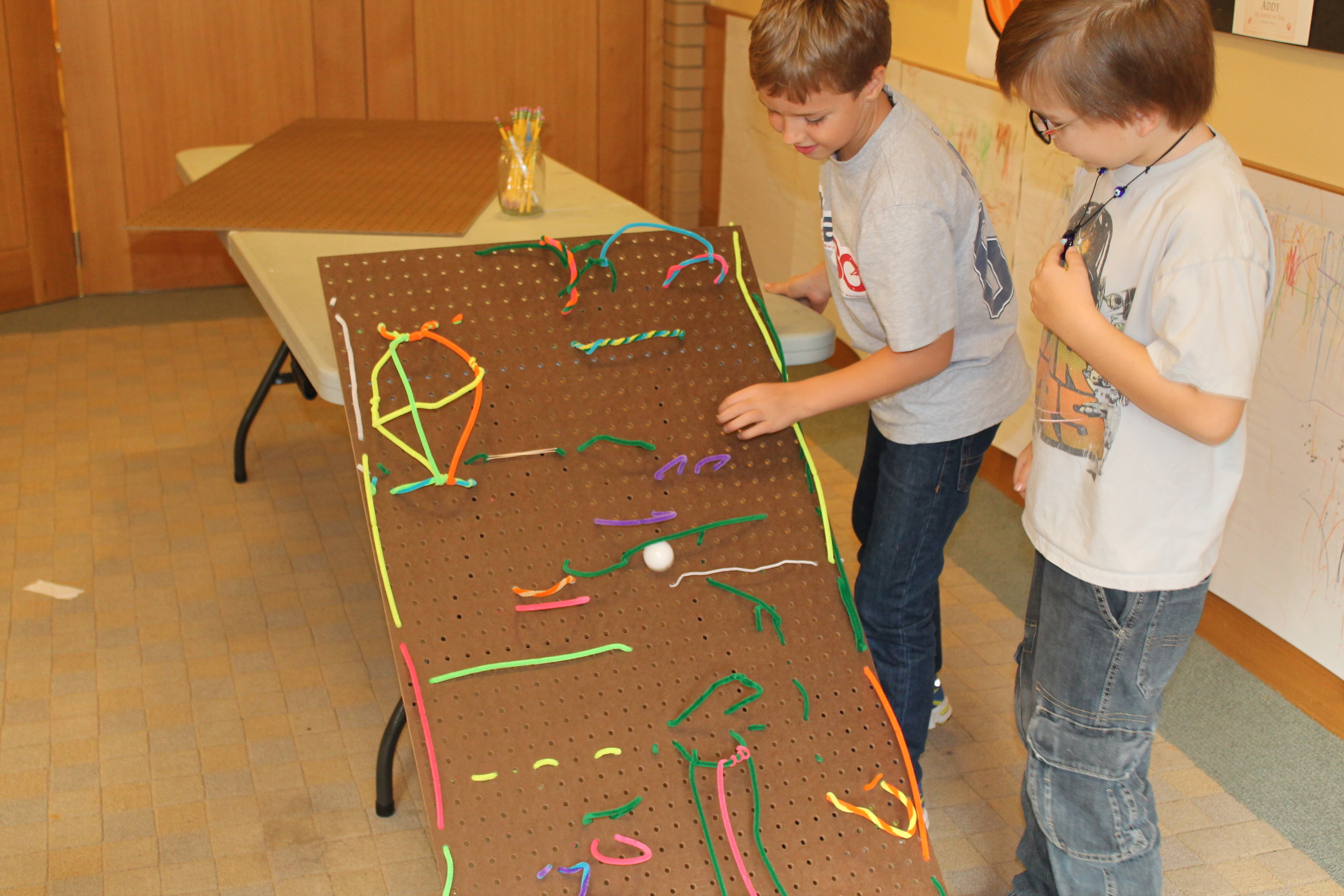
And now to find ways to make our TEA room/Maker Space more accessible and inspiring!
New Creativity Paradigms
I've been so inspired by the book New Creativity Paradigms: Arts Learning in the Digital Age by Dr. Kylie Peppler. When I think about what I want to do in my life, not just in my library job, a lot of the ideas are in this book. Its constructionist foundations are an enunciation of what drew me to librarianship; Papert's ideas are so similar to what I’ve been thinking about as an artist and librarian: “Theories of constructionism further assert that people construct new knowledge particularly when they are engaged in designing and sharing an artifact within a community” (2014, p. 10). I have always thought that facilitating the construction knowledge communally is a thrilling idea – though reading over this, it sounds so dry. I just want to help people make things and find/amplify their creativity and connect with each other!
More on New Creativity Paradigms: it’s youth and interest-driven, instead of prescriptive and achievement based. It engages multi-disciplinary arts, including (or especially) technologies. It’s informal, and sometimes falls out of the bounds of what people consider art – ie posting on a blog, or remixing a song, or creating a silly video.
I don't necessarily think these ideas are new. Connected Learning says a lot of similar things, and these theories of education are from the 90s and earlier.I think what Peppler does well is integrate art and Art ideas: “Art with a capital A usually refers to those genres and works at the center of formal arts curricula, embodiments of highly valued creative practices, pedagogies and movements transmitted culturally between generations. Art with a lower case a, on the other hand, includes modes of expression that, while meaningful to its creator, can fall outside of the aesthetic perimeter of formal institutions” (p. 5). I think art is an amazing framework for thinking about how to encourage people to open up to new ideas and to each other and has incredible potential for creating social change, especially when freed from traditional ideas about what makes good art and the purpose of art.
I’ve been thinking of ways to implement this in my library work, and I’ve found that a lot of small ways are adding up to larger ways. For instance, I do open-ended crafts (I call it art) in storytime – none of this stick a pre-cut triangle on a pre-drawn pumpkin kind of thing (nor coloring pages, though I understand their importance in helping with motor skills). So far we’ve done some fun things, including making a “Wish Portrait” out of contact paper and sequins and drawings, and doing “dance drawing” where we dance with pens in our hands. I also am thinking of ways to arrange our makerspace to be more open-ended, inspirational, and encouraging. And I will try to never make a bulletin board that isn’t participatory. I have big dreams for longer programs and art camps and other things that may or may not be right for a library setting in a town where kids are very scheduled and busy, but I’m willing to try!
I do feel like this connects to another article I read recently that I can’t get out of my head. “Locating the Library in Institutional Oppression" by nina de jesus (2014) on In the Library With a Lead Pipe's blog does just what its title says, looking at libraries an Enlightenment and liberalist project, which follow and perpetuate logics of white supremacy – especially slavery, orientalism, and genocide. Those are definitely serious claims, especially because librarians so often come from a place of wanting to help people and wanting to make them more free, not less.
de jesus posits that as a project of the state (the state being more than just the government – it’s also power and privilege), libraries end up perpetuating the racist, sexist, and many other -ist ideas that the state needs to hold power – for instance, wage war on people that have been “Othered” enough that killing them is acceptable to a wider population. Regardless of the intellectual thrust of this article, some of which would need a lot more expanding and expounding in order to convince me, I was mostly taken with its understanding of neutrality in libraries: “The main notion of neutrality that I challenge within this article is that of institutional neutrality. Regardless of many people’s feelings about the coherence of individual neutrality, many have taken it as axiomatic that libraries are neutral institutions and that any failure of libraries to be neutral is largely the fault of individuals failing to live up to the ideals or ethics of the profession, rather than understanding the library as institution as fundamentally non-neutral. Libraries as institutions were created not only for a specific ideological purpose but for an ideology that is fundamentally oppressive in nature. As such, the failings of libraries can be re-interpreted not as libraries failing to live up to their ideals and values, but rather as symptoms and evidence of this foundational and oppressive ideology.”
This argument, that libraries are implicit in perpetuating Orientalism by asserting neutrality, is some of the most interesting to me. In the author’s discussion of Orientalism, which was developed by Edward Said, they discuss information and knowledge: “Part of what made Said’s work so groundbreaking and influential is that he demonstrated the way that knowledge creation within the empire is not (and never has been) a neutral activity and so the knowledge itself cannot be neutral” (de jesus, 2014). This idea is so important for librarians; I think that rethinking neutrality in libraries has a lot of room in it for action (and - librarians talk so much about upholding democracy - can one choose the political system one operates in and then decide to be neutral within that? I don't think so). What I mean by that is – as a librarian, I have absolutely struggled to be as neutral as all the classes in library school told me to be. I think neutrality is impossible in most everything, similar to how I feel about objectivity. There are lots of interesting works on objectivity and science that say what I want to say a lot better.
However, in a library I also think pluralism is possible – that there is room in a library for a lot of viewpoints and ideas, and that viewpoints and ideas are inherently plastic and therefore exposing people to many ideas is vitally important. A library has a role to play in making information available, including criticisms of itself and its funders, and of dominant paradigms, and upholding pluralism and active listening of what information and ideas are relevant to provide and discuss. Understanding that a library is not a neutral space is an exercise that can help librarians think about their goals in their work, as well as how funding sources change mission statements and if we really truly want to model ourselves on business principles, as is sometimes proposed these days.
Another aspect of this article is the articulation of libraries as perpetuating the logic of capitalism. This has become clear to me in the difference in the types of libraries I have worked in – mainly, the difference between a large urban system and a small, wealthy town system. The small, wealthy town library is very financially well supported by its wealthy residents and has access to many resources and people; its model provides the very best for its patrons. The discrepancy between this library and the large urban library I interned with are so stark – that library has very limited funds available for a population that needs the library for basic services as well as for the more cultural spaces a library can provide (think Maslow’s Hierarchy of Needs). This logic of capitalism says that if you have more money, you deserve better services because you earned it - but if you don’t have enough money to improve your services, you deserve what you get. This applies to public schools, transportation systems, sanitation services, the prison industrial complex, etc. all over this country.
This connects to New Creativity Paradigms because in thinking of what kind of library I want to be a part of, I want to create a pro-creativity library – one that asks people to think big, look back, and regard each other. I don’t necessarily think that’s a neutral idea – in fact I know that’s not a neutral idea. I wanted to be a librarian because I wanted to create spaces for those ideas and discussions to happen and bloom, and I think that includes thinking deeply about both creativity and the space of the library. This can happen at any library or library-like space – one that is trying to help people by working to open access to ideas and resources to better their lives.
Fred Branfman
I have just learned that Fred Branfman has passed away. I met Fred while in Vientiane, Laos. Fred had been instrumental in exposing the Secret War in Laos. Here's a summary of the Secret War from Legacies of War, a US non-profit dedicated to raising funds for bomb cleanup in Laos and education in the US: "From 1964 to 1973, the U.S. dropped more than two million tons of ordnance on Laos during 580,000 bombing missions—equal to a planeload of bombs every 8 minutes, 24-hours a day, for 9 years – making Laos the most heavily bombed country per capita in history. The bombings were part of the U.S. Secret War in Laos to support the Royal Lao Government against the Pathet Lao and to interdict traffic along the Ho Chi Minh Trail. The bombings destroyed many villages and displaced hundreds of thousands of Lao civilians during the nine-year period."
Fred, who was living in Laos as an educational adviser during the Secret War, was shocked to learn about the bombing. He collected interviews and drawings from refugees of the bombing, published them into a book, Voices from the Plain of Jars: Life Under an Air War, that exposed what was happening. He informed Congress of the bombing, generated national media, and investigated U.S. bombing activities in Thailand and South Vietnam. The testimonies he collected continue to inspire action through Legacies of War - you can see the illustrations online here; unfortunately, up to 80 million of the cluster munitions did not detonate and continue to be a risk to Lao children, farmers, fishermen, and people across the country.
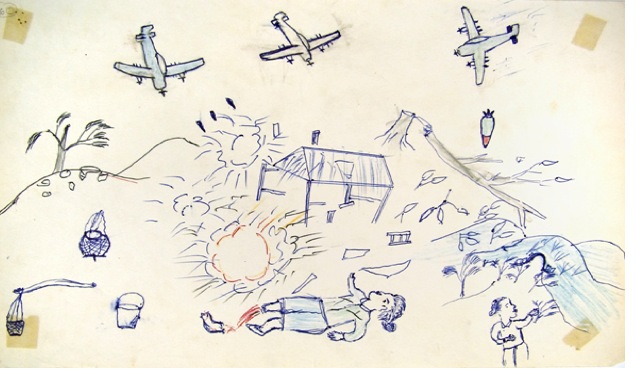
Fred was an inspiring figure for me, and I was moved by the power of the images he collected and his life's work. I had come to Laos from Oakland, CA, where I had been involved in anti-prison and anti-policing work and was trying to find energy to do social justice work in a world that felt violent and scary. Our discussions showed that Fred was truly a seeker - he was actively searching for truth, for justice, for meaning, for compassion, and for steps to take in solving the many problems of our world. I was feeling so full of sadness for what had happened in Laos and meeting him was so important. He also wrote about meeting in an article that wasn't published, called A Week on the Plain of Jars:
"I was having a last talk in Vientiane before hailing a taxi to take me to the airport to fly up for my week in the Plain [of Jars], with a sensitive young American woman. She was a newly arrived Fulbright scholar who had just arrived to spend a year in Laos, and had been learning about the bombing and its thousands of victims since. She happened to be 25, my age when I had first arrived in Laos in 1967. As our conversation was ending I asked what her goal was for her next year in Laos. She responded: "To learn to live with the sadness." And I suddenly knew what I hoped to achieve during the coming week."
During my time in Laos, I tried to continue his work. I worked to try to bring Voices from the Plain of Jars into schools in Laos (and failed - the political climate made it impossible to achieve), but I did manage to facilitate the creation of beautiful art work by 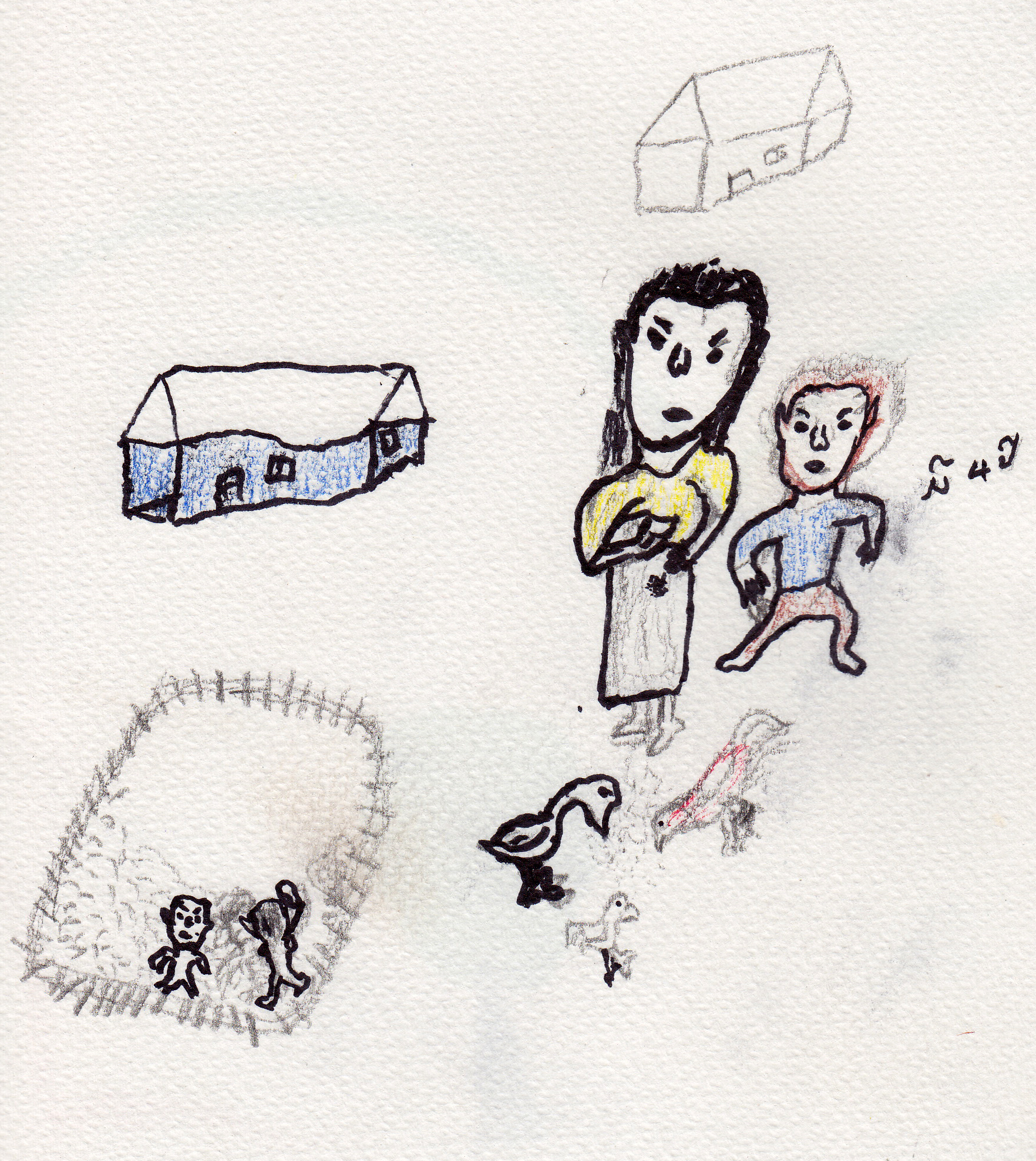 Lao children and youth who had survived accidents with bombs leftover from that war. Their work lives on in Xieng Khouang, in murals in the Quality of Life Association visitor center. I had dreams of bringing the drawings to the US in an exhibition, and still hope to, though many of the originals were lost by the postal service. If you know anyone who is interested in displaying this work, please contact me.
Lao children and youth who had survived accidents with bombs leftover from that war. Their work lives on in Xieng Khouang, in murals in the Quality of Life Association visitor center. I had dreams of bringing the drawings to the US in an exhibition, and still hope to, though many of the originals were lost by the postal service. If you know anyone who is interested in displaying this work, please contact me.
Fred continued to visit Laos, as well as work with many of the other sadnesses around the world. He was a prolific writer and thinker. I have thought of Fred many times since I last saw him, as an example of a person who could hold many of the world's sorrows and not be destroyed by them. This is a rare gift, and not one I'm sure I have. It is so easy to medicate this sadness (and there is so much to be sad about! Racism, sexism, the environment, gun violence...it's all happening just down the street or to us all) with making money, or buying nice things, or burrowing into a comfortable life. I remember Fred today and his commitment to having a capacious heart (in the words of Kate DiCamillo) and to using his heart to guide him forward, no matter where that took him. I honor him and his work and feel sad that this world doesn't have him in it any longer. However, we will always have the work that he has done all over the world, and his legacy is one of peace; remembering Fred fills me with sorrow but also with so much happiness - joy that he has lived.
What's an artist librarian?
When I've applied to everything librarian-related, I talk about my background as an artist. It's become a certain litany, though I haven't been creating as much art as I'd look to. I have many half-finished ideas lying here or there, and I mostly have my past and future as an artist to guide me in my assertion that I'm an artist-librarian. I'm not really sure what that is yet. Does that mean owning this URL and having art projects on it and a separate page for librarian activities? Does it mean being librarian by day and artist by night? Or - can it possibly mean a beautiful union of my ideals in librarianship and art?! Now in my first job as a librarian I'm trying to sculpt what that means. I became a librarian because I think the library is the perfect container to involve people daily in creative practices that connect them to each other and to big ideas. And art is the perfect tool to help people imagine what it is they want and be creative about how to get there. That sounds so great in theory but I don't know what it means on a day-to-day level, where I also have to make sure I'm doing my job well.
I'm starting to get an inkling about what it could mean, as I learn more about the community I work in and my library. It could mean encouraging creative, messy, and open ended arts projects in a place where achievement-based projects are valued. It could mean finding a way to educate people in what it means to be making community-based materials instead of consuming what is produced. It could mean encouraging participation in politics, culture, and all the intersections in between.
I think what drew me to the arts was the openness of the field. Artists I admire are trying to be themselves and do their work in the most authentic way they can, and the field (sometimes) has room for those people to try and fail, and follow their ideas and passions. In my ideal world, I see a place where all people feel that feeling - that their work is valued and they are following their interests (passions? joys? what is a good word for that?) and that those interests are generally helpful to other people. Maybe I can bring some of that framework into the library.
I need to look to mentors/artist librarians I admire for ideas as well.
I think it's a good sign that these recent posts have felt so question-based - it's like I'm in my early 20s again! I'm in my career second puberty.
Vision and goals
I now work as a children's librarian/the Harold W. McGraw fellow at Darien Library! It's my first full time librarian gig as a master of information - I graduated in May. Last week we had KidLib Camp - an "unconference" for youth librarians. An unconference is basically a conference organized by the attendees - they vote for the topics, volunteers facilitate, and they share their takeaways. Amazing youth librarians from all over CT, NY, and NJ (even RI!) came and contributed their energy and brilliance.
We opened with a keynote by Lauren Britton, an inspiring PhD candidate who has been a driving force in introducing makerspaces to libraries and encouraging transliteracy. It was particularly important for me to hear her 30 minute speech because I've spent the last 3 weeks getting a handle on my job and impatiently imagining what projects I want to do as a fellow, and this helped me remember why I became a librarian. Watch the speech below, or you can see tweets about it here.
KidLibCamp 2014 Keynote: Lauren Britton from Darien Library on Vimeo.
I have still not figured out what I want to do as a librarian. When I imagine myself in 10 years, I either see myself being "successful" (ie traditional leadership role in my job and in professional circles) or being successful in more artsy ways (ie doing some project that is rad and replicable and connected to other fields) - or maybe some hybrid. I want to be doing what Britton says - not being obsessed with singular tools (ie books!) - but be thinking of the larger goal and vision in libraries right now. Understand tools but know that they are connected to larger skills and purposes - and the tools I want to specialize in definitely include art, books, and technology. I wrote something for my application at my job about how art and libraries both can help people remember their past, be empowered in their present, and envision their future, and now I want to figure out how to put that into action.
My next step at work is to come up with some big visions and take my ever-growing list of project ideas and see which ones fit.
AWESOMEBOX
Inspired by Harvard's Innovation Lab, I created an Awesomebox for the Head-Royce Library.  OK, so it's not particularly gorgeous or fancy, but it's a prototype.
The idea is that if someone loves their book, instead of dropping it in the book drop they put it in the Awesomebox. Then, I post on social media that it's been Awesomeboxed:
OK, so it's not particularly gorgeous or fancy, but it's a prototype.
The idea is that if someone loves their book, instead of dropping it in the book drop they put it in the Awesomebox. Then, I post on social media that it's been Awesomeboxed:
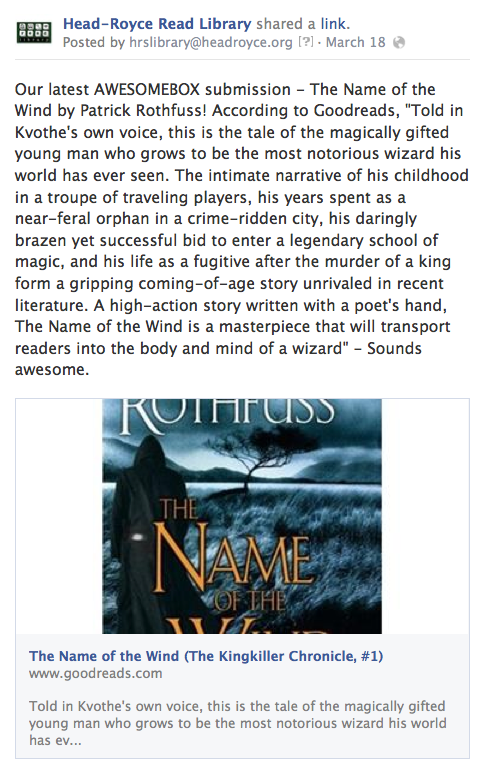
And add a tag in our catalog, so when you search Awesomebox all books marked as such show up.
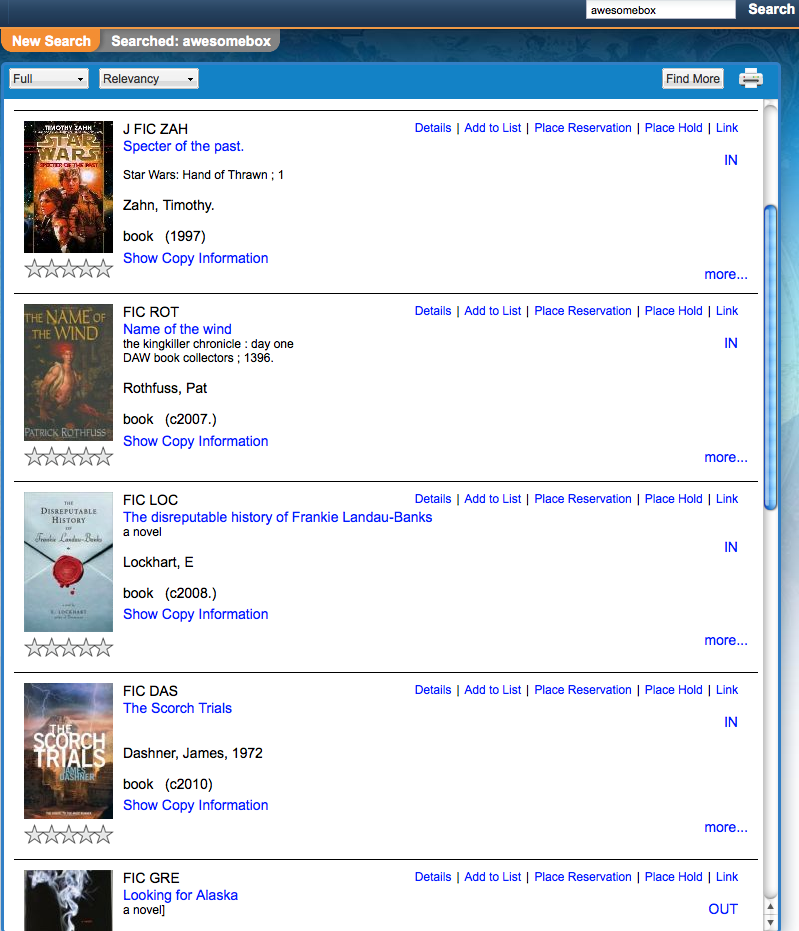
We've had a few high schoolers/middle schoolers who drop their books in with great aplomb, but generally people are pretty apathetic to it. It's my philosophy that if something can be fun and show that we're interested in what people have to say about our materials and library, it's worth it even if it's not an instant hit. So it stays!
Stockholm's Library
My mom is Swedish, so I get to be a dual citizen and speak Swedish and have family in Sweden and eat a lot of Swedish treats. It's a good life.
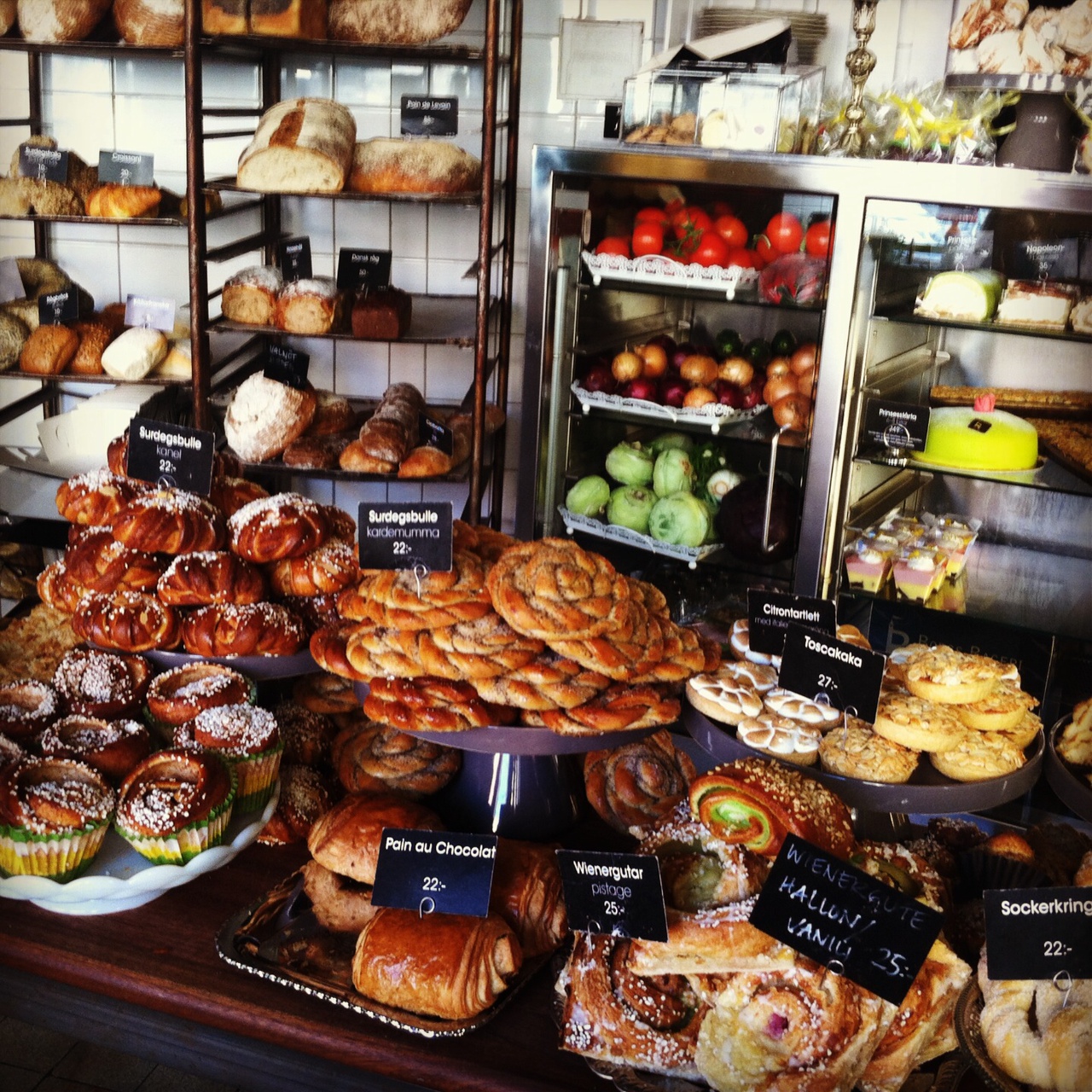
I was recently in Sweden visiting my sister Kristine, a badass opera singer, and got to go the city library. What a glorious place! It's in a cool round orange building:
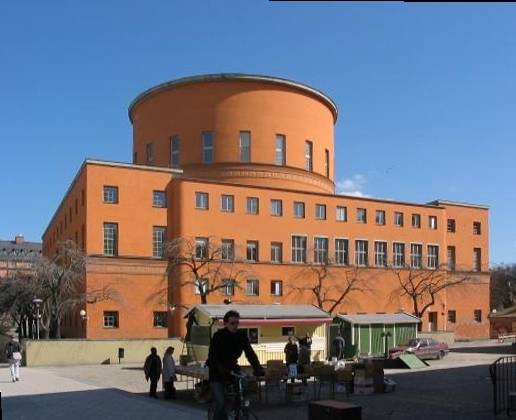 built in 1928, the first library in Sweden with open stacks.
built in 1928, the first library in Sweden with open stacks.
I wandered over the children's room first, which was through a cool hallway with two separate entrances. There were cute paintings on the wall and lots of book suggestions and program flyers.
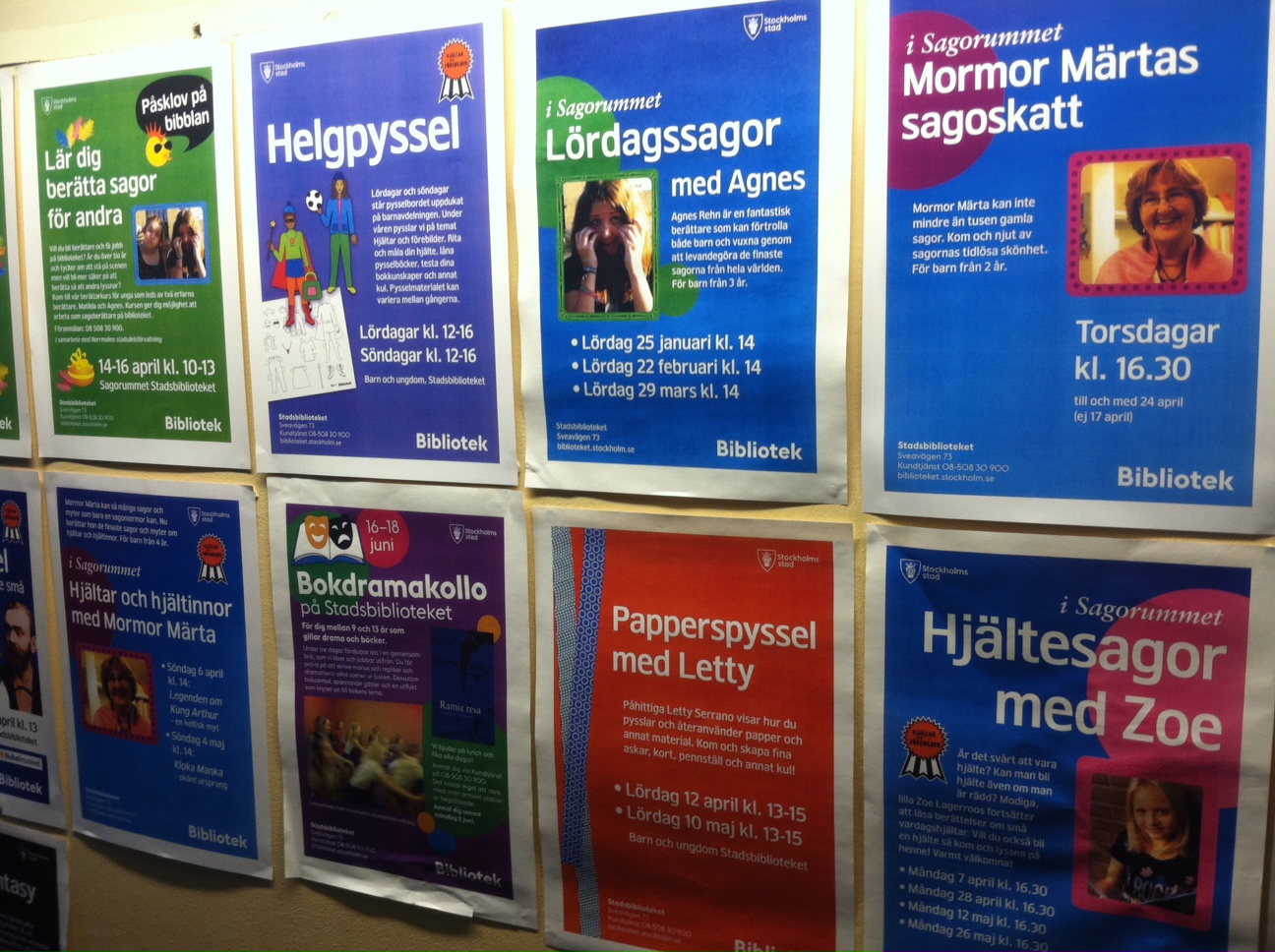 Programs included a teen book club, a storytime, events for spring break (or Easter break as they call it), a book drama club, hero stortyimes, and storytime led by a tween(!). So great. Book recommendations - on these special little postits with "My book tips" in the corner, included Hunger Games, Twilight, Narnia, and the Book Thief, and some great Swedish books.
Programs included a teen book club, a storytime, events for spring break (or Easter break as they call it), a book drama club, hero stortyimes, and storytime led by a tween(!). So great. Book recommendations - on these special little postits with "My book tips" in the corner, included Hunger Games, Twilight, Narnia, and the Book Thief, and some great Swedish books.
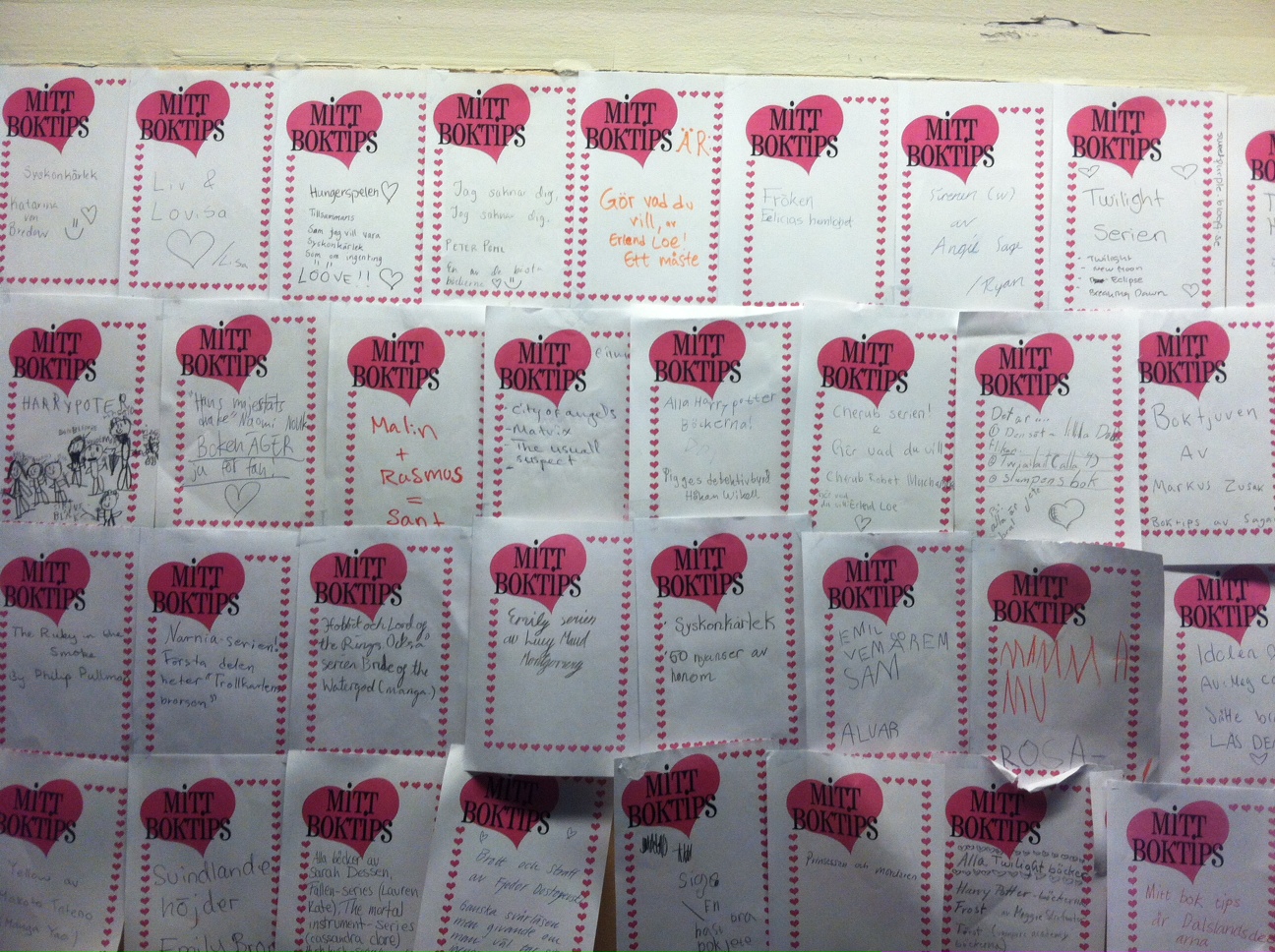
Most of the picture books were stored in great little wooden rolling carts at kids height, with all the books facing out. Books were alphabetized by author. Most of the books had an interesting library binding, and they did not use the Dewey Decimal system to organize the books - nonfiction had subjects too, and the fiction was organized by age and author.
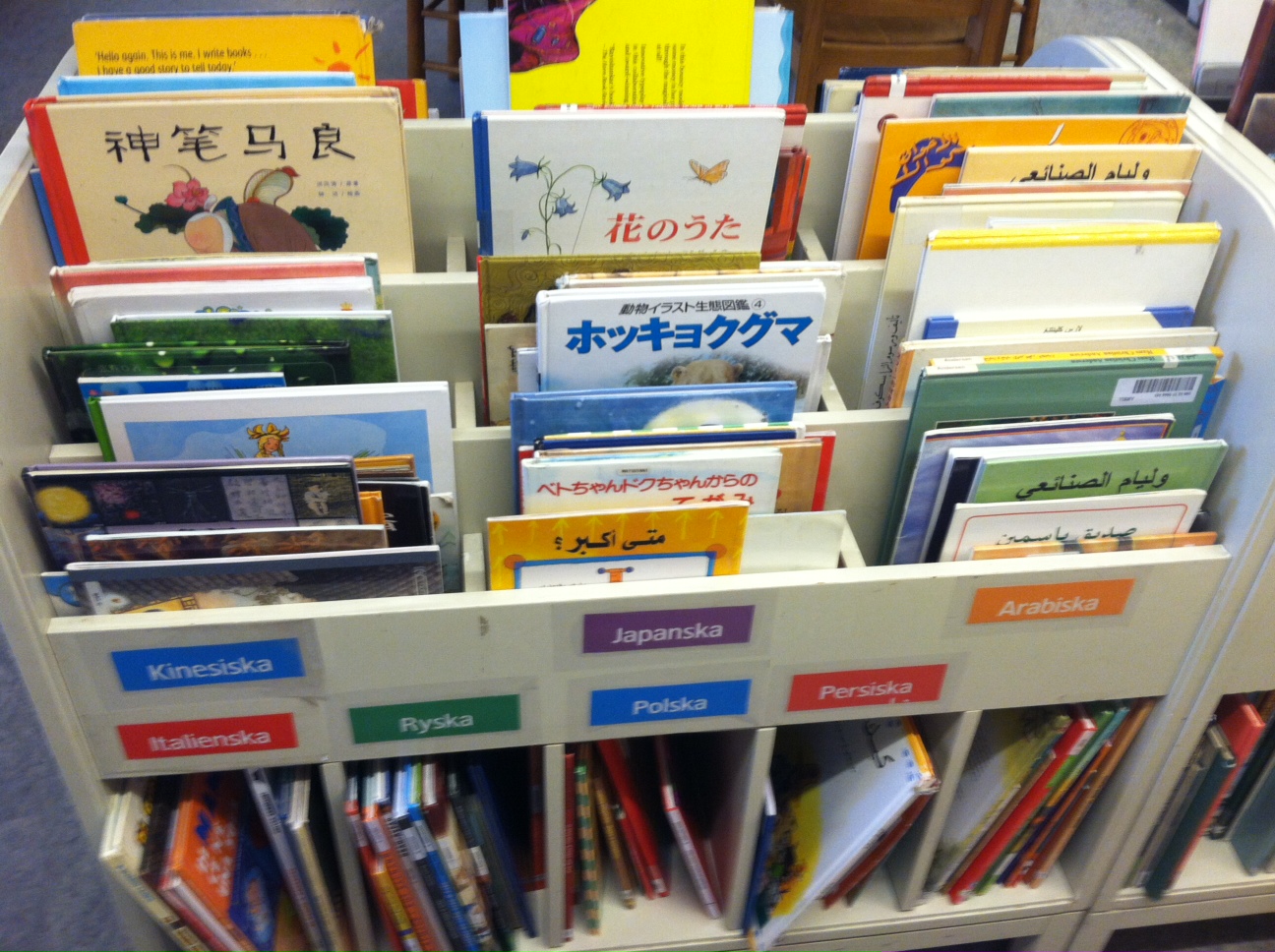
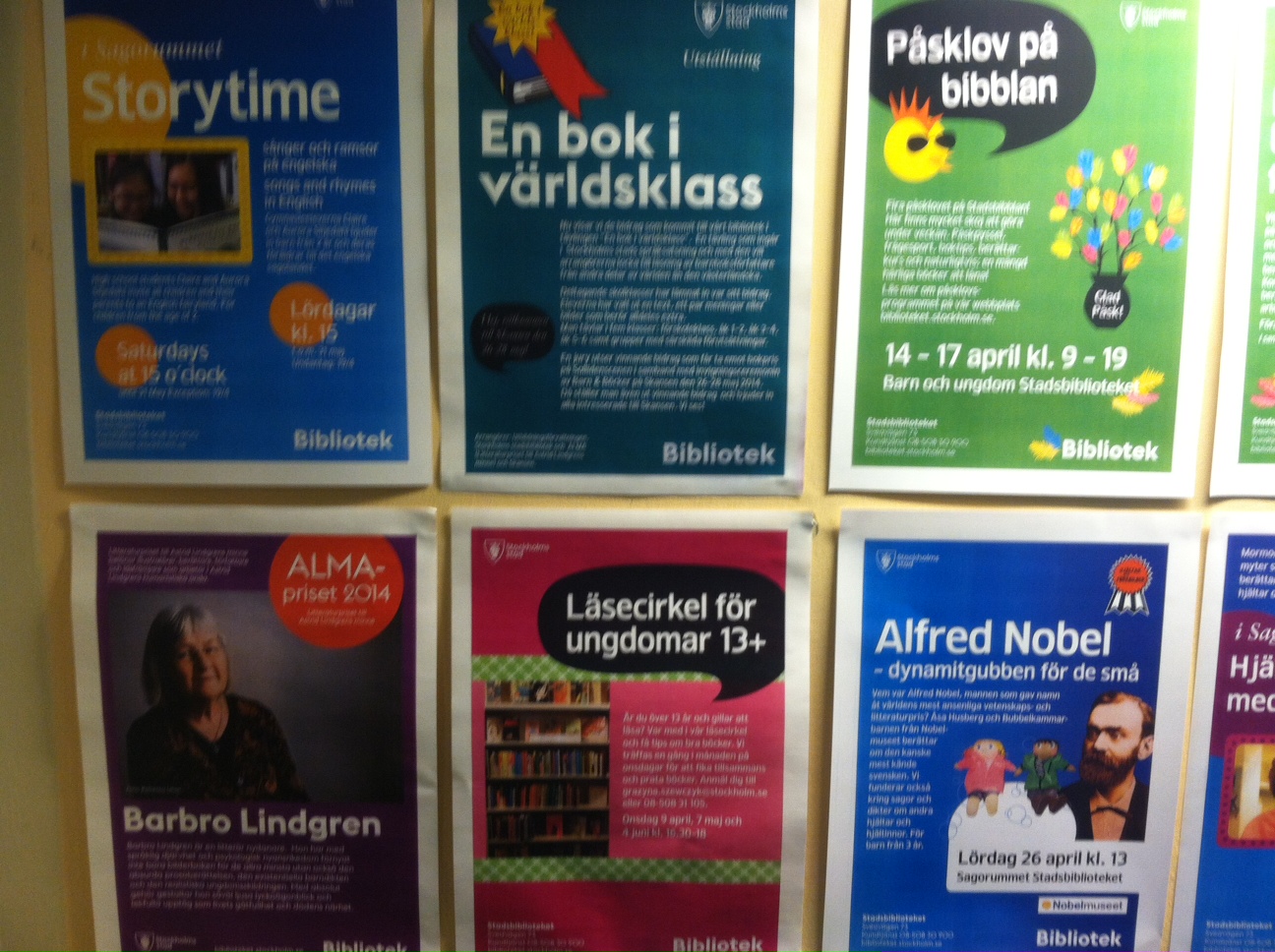
And check out the incredible story time room. It was circular with this crazy mural on it.
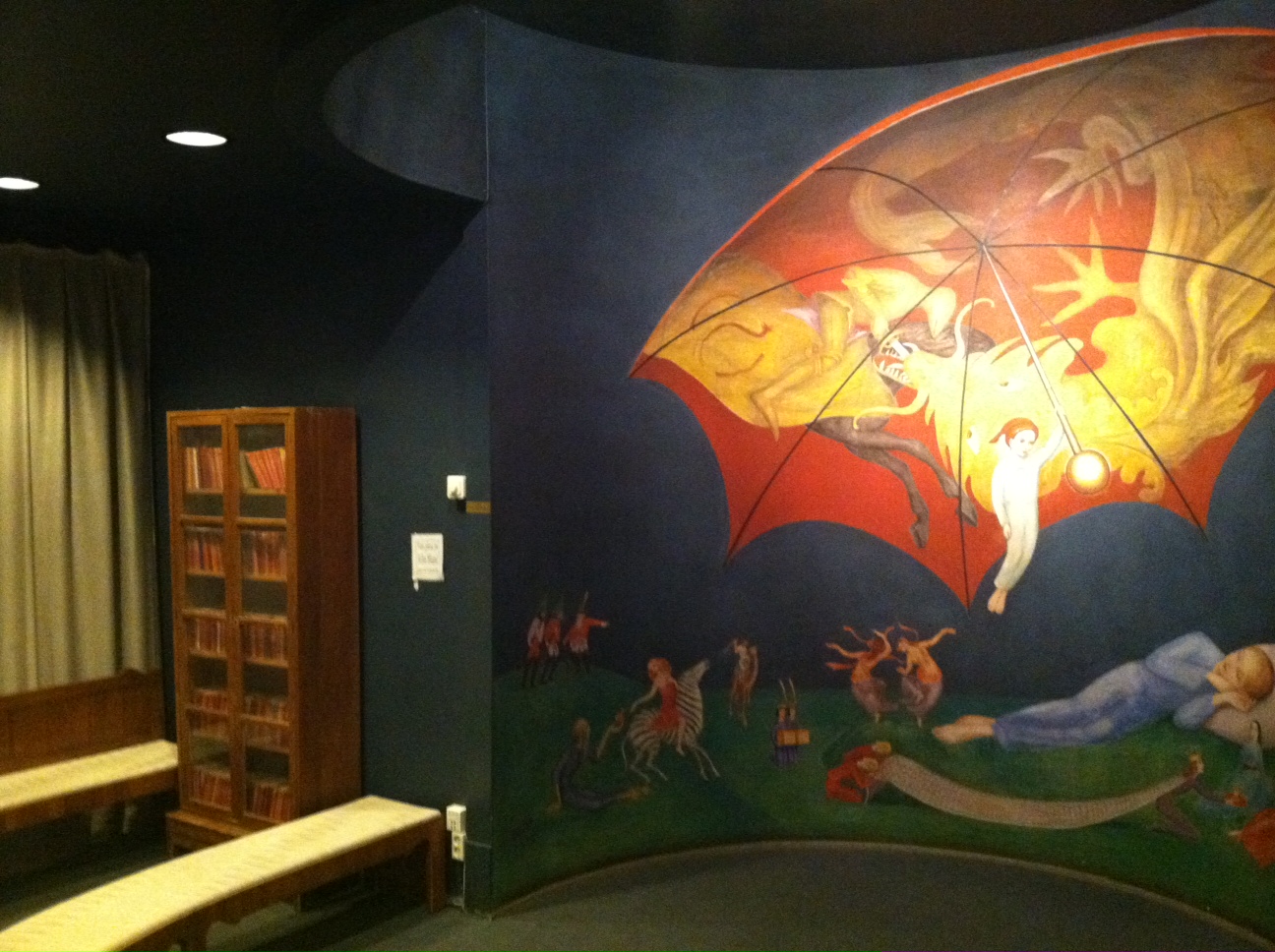
And then moving on the adult section of the library - the rotunda! So beautiful. Felt like a classic old citadel of knowledge in there. I was surprised by the grumpiness of the elderly lady librarians in there - definitely the shushing kind who looked annoyed anytime someone asked for help. Very disappointing. Pleased to see the Children's Librarians were super friendly - though they were mostly sitting behind the desk and not roving around (luckily the desk was short and approachable!)
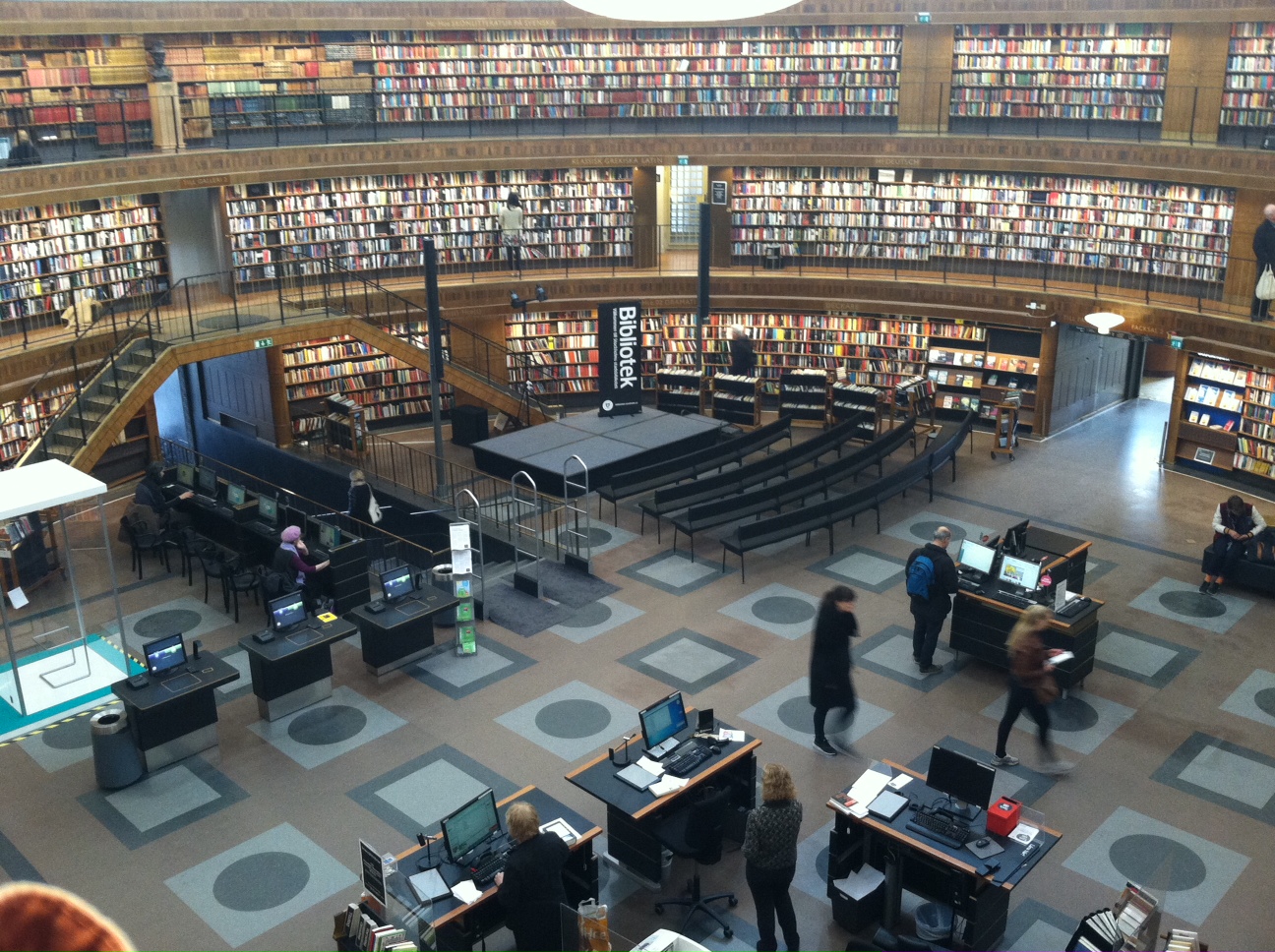
A very cool little hallway above the rotunda had an incredible poetry installation, with hip wallpaper and little curated shelves with poetry books on them.
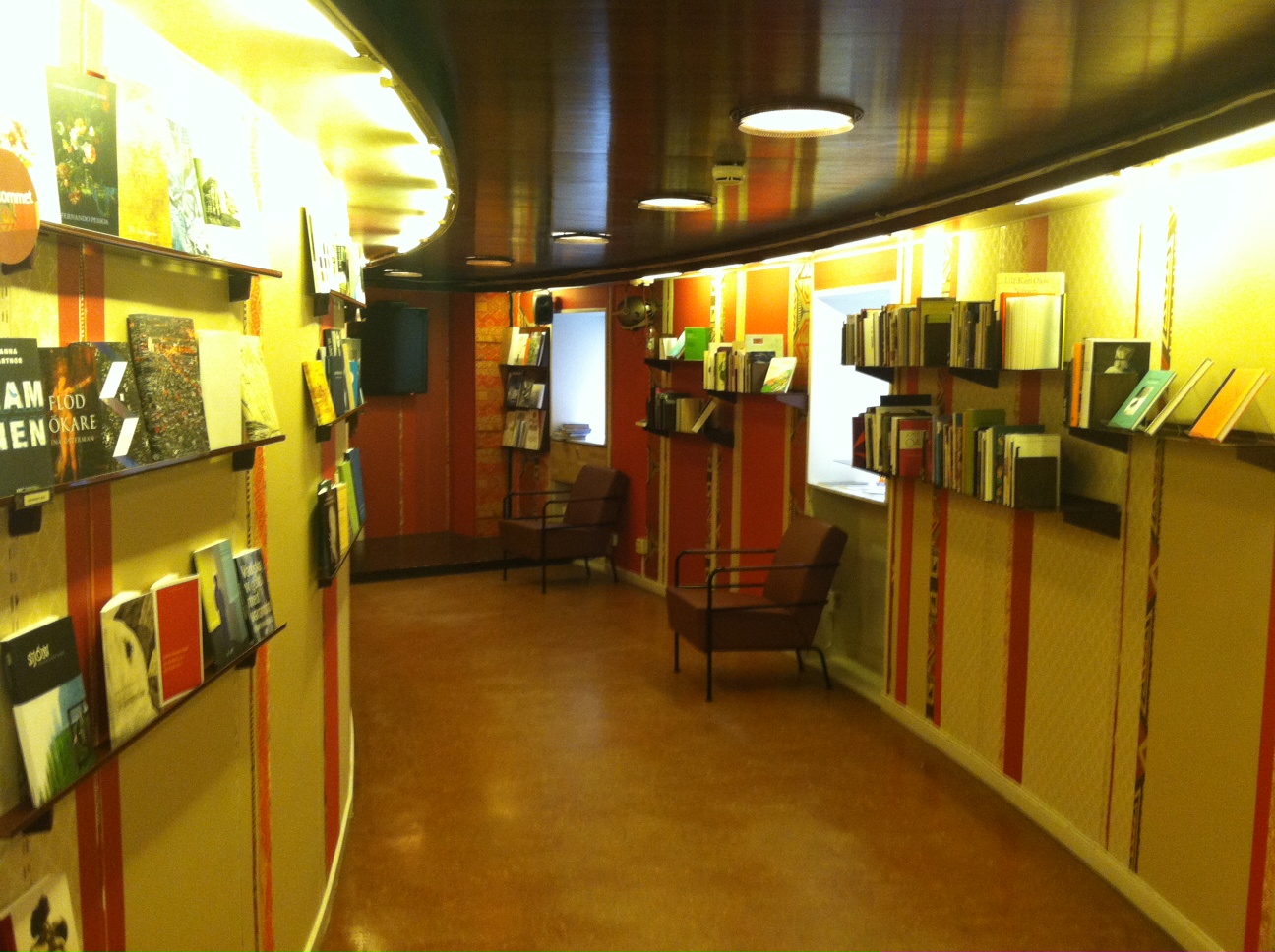
The library also had a great cafe (with the proper Swedish sweets!)

I wandered to the library sciences section and found a book called Bibliotek 2.0 - or Library 2.0 - that discussed all the participatory, technology-forward aspects librarianship could take today. Sweden seemed like it was doing a lot of that, at least in the kids section, with user-friendly shelving and space organization, and lots of interactive programming. However, the grumpy librarians were a disappointment. When I went to check out their website, it said it was down for 3 days because they are updating it. Interesting!
My favorite children's book
For all the reasons listed above!
Banned book week

 Above are pictures of a display I did at work for Banned Book Week. I found some of the most banned books in the USA, made a book cover for them that described why they were banned, and gave space for people to write whether or not they believed the reasons for banning the book were legitimate. There were also small informational signs about the difference between a challenge and banning, who bans books, and our library's policy.
Above are pictures of a display I did at work for Banned Book Week. I found some of the most banned books in the USA, made a book cover for them that described why they were banned, and gave space for people to write whether or not they believed the reasons for banning the book were legitimate. There were also small informational signs about the difference between a challenge and banning, who bans books, and our library's policy.
I was in Collections Development class for my MLIS at the time, and was thinking from a collections management perspective, and about whom I wanted the collection to serve. When I was reviewing many of the banned titles, many of which are classics that have racist or sexist words or pretenses, my understandings of what it meant to be a librarian shifted. We really do have to walk the line between serving our patrons, our libraries, and our ethical duties to our community. It's so important to realize that our work is subjective, while attempting to stay open to the variety of views and ideas of our patrons. I appreciated thinking about whether libraries should filter internet content as well, for similar reasons. I don’t want to have a library that filters, censors, or otherwise commits intellectual “crimes.” However, in learning about the actual skills and processes behind selection, my perspectives have broadened and grown. Does not selecting a book mean that it’s being banned or challenged? Is it a good policy to wait until a patron requests the material that may be on the line of what I personally would want in my library? What are my duties as a politically involved person who is firmly leftist to those who don’t share my political beliefs?
I do think it's important for libraries to celebrate banned book week, as a way to engage with ideas around censorship - both for their patrons and themselves. This is a wonderful project I would like to do for next year!
Exploratorium de-brief - yore from summer past
I had a great/typical/crazy experience working at the Exploratorium this summer. I came on to the project with the understanding that the library was expanding, hiring a librarian to supervise me, and I would be working with teachers from the Teacher's Institute (a science-based educational program for teachers). However, on my first day, I was told that the library was experiencing serious budget cuts, that money that had been promised to them had been retracted, and that I had no one to supervise me and I would have to wing it with the teachers and any other work they could scrounge up for me.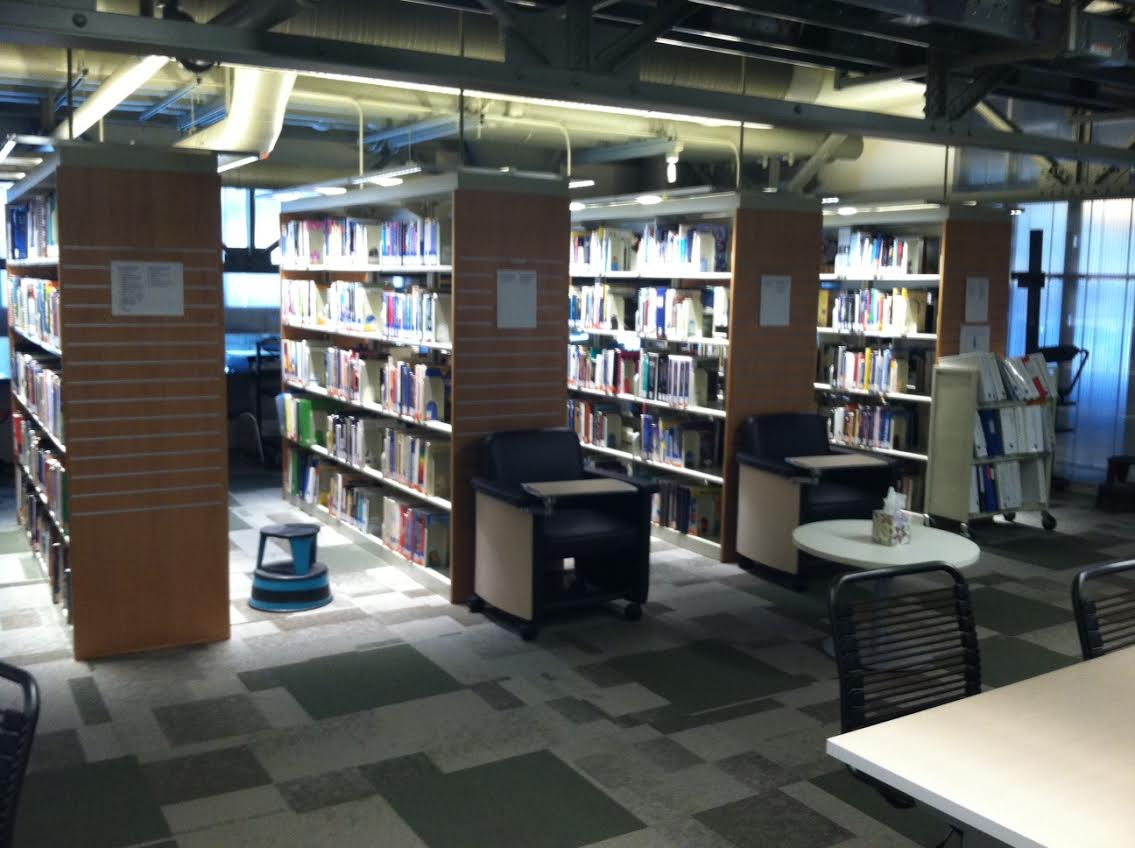 As someone who has worked with a small business, non-profits, and in Laos (where things move slowly and change rapidly), I'm quite used to sudden changes in solvency and staffing. In my pre-librarian experiences, I've learned all about patience and flexibility, which I've gathered is particularly important in the library world.
As someone who has worked with a small business, non-profits, and in Laos (where things move slowly and change rapidly), I'm quite used to sudden changes in solvency and staffing. In my pre-librarian experiences, I've learned all about patience and flexibility, which I've gathered is particularly important in the library world.
I really enjoyed the experience as I helped teachers find resources that worked for them in our wonderful library and learned to use the catalog and media archive. I had never done digital archiving before, but as a web designer, office manager (who did some IT), and artist, I knew that organizing things digitally makes sense to me. The wonderful librarian and digital archivist taught me how to digitally archive teacher-created binders (full of lessons and wisdom) and the Exploratorium's awesome magazines, and I was off and running, adding metadata that would be useful for teachers, categorizing, and tagging. I never knew it would be so fun! By the end of the summer, the head librarian was so satisfied with my work and flexibility that she wanted to hire me as on-call staff for a variety of projects. Sadly, the library was closed this fall and the librarian was laid off.
Wow! The layoff were not without drama. I had many conversations from the beginning of the summer on with my supervisor (who has been there since 1985) about the politics of libraries - how to save them, advocate for them, and keep them open in the face of ignorance, greed, or just dumb bureaucracy. She told me about the energy it takes to create and sustain innovative programs while proving their efficacy and preserving their budgets. I have had conversations about the Oakland Public Library system's struggles to stay open in spite of its deeply felt use to the community and exciting programs. While I think a little struggle can push innovation (for instance, some very wealthy systems are mired in their old ways), too much energy spent fighting and advocating can destroy both a librarian's will to keep working and the integrity of the programs themselves.
I had to be very flexible in another part of my summer, which was the 81st Avenue branch mural project. I tried to run a weekly arts workshop, but had trouble with scheduling (the teens weren't available when I was, so the workshop was mostly tweens), so I changed my thorough curriculum into a one day instant mural workshop, with assistance from two teen volunteers. While the result was a bit amateur, I felt that the process was preserved - teens created the mural The finished instant mural - a 5 hour workshopfrom start to finish. I felt like these two experiences were really educational in terms of learning to adapt, I also felt that they showed when to fight and when to adapt, and how to do both at the same time. With the mural workshop, I was trying to adapt to the constraints and commitments of the youth I was working with, and my own ability to make it happen. At the Exploratorium, I was learning from my supervisor when to push back, after having budget cuts year after year - though I'm not sure what the final lesson was (too much pushing? or out of her hands? I don't know!).
Oh man, I am so excited about creation culture.
This post was written for my Libr 287 - Hyperlinked Library course I took in the Fall of 2013. I came to librarianship from an arts background because I thought libraries had the power to connect people with information and each other for social good, just like the art I always wanted to do. And creation culture is a very exciting way that libraries can do this.
I understand the criticisms. “It leads you to the tangible – that’s not your job. It is the concept of the intangible that connects all the objects librarians have traditionally dealt with- books, records, photographs, magnetic tape and compact discs. It is this tradition of dealing with the intangible that makes librarianship such an exciting profession right now” (Rundle, 2013). However, the intangible is also about connection and belonging and skills, all things a library can create though maker spaces and other creative incubators.
Beyond philosophical reasons for creation culture in libraries, it’s clear that if we are not dipping our space and staff into that world, the world will pass us by. “More recently, the exploding popularity of YouTube shows that people are interested in small, personal productions” (Jacobsen & Anthony, 2011). The general culture is moving towards more production on an individual or community-based level, equipped with tools both new and old, emerging and well-worn. And none to soon, what with the consolidation of corporations and media conglomerates - citizen-based information creation is as important as ever.
I appreciated Zeke Leonard, assistant professor at Syracuse School of Design’s quote in Britton’s (2012) article.
“Making anything for yourself is a political act,” says Zeke Leonard, assistant professor, Syracuse University School of Design. “The further we get from the creation of an object, the less we have a connection with the people, resources, and process. This limits how we assign value to objects. If we can all start to make more and consume less, then we can be more thoughtful about the resources used to create the objects and food and garments that we fill our lives with,” Leonard says.
When people are creating objects, ideas, and information in their own communities, it can draw a community closer together to create resiliency and power. And librarians are very well positioned to do so. Maxine Bleiweis, director at the Westport Public Library, was quoted in Britton: “Bleiweis says the library is there to provide the framework, not to be in charge. She says there is a shift from a librarian being the person who had all of the answers to the person who has questions and the ability to find the answers.” However, I disagree. I think librarians were always the people who had questions and the ability to find answers – it’s always been about other people’s content, there’s just been a flattening of who’s content. There has been a shift away from the ways that libraries work institutionally towards user-based and participatory, but librarians have always been framework creators for others to use. I agree with Doctorow (2013) when he says, “Public libraries have always been places where skilled information professionals assisted the general public with the eternal quest to understand the world.” Sometimes you have to create in order to understand.
To end my blog post for today, I’d like to share some awesome art about libraries. Check out Alice Walsh, Lost Memory by Theresa Moerman, and the Reading Nest by Mark Riegalman. These are lot more formal than say, the magic coming out of Oak Park’s IdeaBox, but I love them all! They all came from the excellent Library as Incubator project, who I am interning with next semester hooray hooray!



Sources cited
Britton, L. (2012, October 1). The makings of maker spaces, part 1: Space for creation, not just consumption [Web log post]. The Digital Shift. Library Journal. Retrieved from http://www.thedigitalshift.com/2012/10/public-services/the-makings-of-maker-spaces-part-1-space-for-creation-not-just-consumption/
Doctorow, C. (2013, February 25). Libraries and makerspaces: a match made in heaven [Web log post]. boingboing. Retrieved from http://boingboing.net/2013/02/25/libraries-and-makerspaces-a-m.html?utm_source=dlvr.it&utm_medium=twitter
Jacobsen, M., & Anthony, C. (2011, November 8). Build your own digital media lab [Web log post]. The Digital Shift. School Library Journal. Retrieved from http://www.thedigitalshift.com/2011/11/media/build-your-own-digital-media-lab/
Rundle, H. (2013, January 2). Mission creep – a 3D printer will not save your library [Web log post]. It’s not about the books: libraries, technology, information, stories. Retrieved from http://hughrundle.net/2013/01/02/mission-creep-a-3d-printer-will-not-save-your-library/
Solutions
Parts of this post were written for my Libr 287 – Hyperlinked Library course I took in the Fall of 2013.
In the San Francisco Bay Area, there's been a lot of talk about taxis vs "rideshare" services like Uber or Lyft. Uber and Lyft allow members to download the app, call up a driver, and pay on a donation-based fee structure. The drivers are anyone with a car who work on a contract basis.
I think it relates quite closely to the intriguing conversations we're having about library services, hyperlinked communities, and our future. In particular, I'm talking about the article "From community to technology...and back again" by Dave Grey. Grey's article speaks of the present and future, when "Rather than waiting for a centralized technology to come along—think of railroads, highways, radio and TV—groups can reach out and take advantage of services and resources that allow them more freedom, more flexibility, more connections, more ways to configure their networks." In the Uber sense, it's people being able to both work for and use this service with low barriers.
There are certainly benefits to this system - it's more affordable, anyone with a car can access the work, and it meets people's needs for a quick, cheap ride. It's described and touted as being under the net of sharing and networked communities. However, in an article on Grist, Susie Cagle says "And the techies and 'sharing' boosters point out that ridesharing allows us to 'leverage excess idle capacity' — that is, fill empty seats — and therefore operate more efficiently. But let’s be honest about this 'excess idle capacity' thing. Ridesharing may be a peer-to-peer economy — moderated by middlemen — but this is not really sharing." Cagle goes on to show that these companies are offering a job, in an economy, with a fee-based service, which shows that: "...so far, this part of the “sharing economy” looks less like an altruistic act, and more like a shadow service industry with few consumer or worker protections" (Susie Cagle, Grist). How is earning money from a service an altruistic act?
The next step is about labor as well as the future of the social safety net. Unlike cabbies, who are required to be properly trained, insured, and meet environmental regulations, Uber and Lyft drivers just aren't. Of course their overhead is lower - the risk for Uber and Lyft, because their workers are contracted, temporary, and work on their own hours, is so low. This isn't to say that cab companies are wonderful employers who empower their workers with full benefits and labor rights (not at all), which in this case seems to be part of the problem. Few are willing to fight for the preservation of the cab companies because they haven't made themselves near and dear to particularly many people.
With these app-based, flexible, and temporary ridesharing services, I also wonder about what the future is supposed to look like. Are we simply hoping to replace cabs and buses with ridesharing? If the criticism is that these systems don't work, and the solution is an app from private companies, I wonder about the long-term vision in transportation. I personally would rather have a thriving public transit system with secure and safe jobs for drivers and affordable fares for riders, and I don't think that the competition from these private companies will necessarily help create that solution.
This relates to the library as well. As we seek to be tech savvy, on-trend, and mobile, are we falling into the games of the uneven playing field of information professionals? Gray says "Companies will have to be more responsive to customer needs and demands if they want to survive." And being competitive means cutting costs - perhaps less unions, less full time, more temporary part-time on-call? As we seek to be improve our services, I think it's important to be watchful for mindsets which are destructive to uninvited idea guests that tag along with the good ones. This includes having a long-term vision for our services, not a short-sighted "solutionism." Evgeny Morozov, a tech critic, says “solutionism” is when the technology is seen as a means to an end, and problems seen as only something to fix in the cheapest, fastest, and most profitable way. I think that leads to the roots of those problems being obscured, and with it our citizen’s power to make deep and structural change.
An example in the library might be public safety in and outside. Say a branch is having trouble with young people in a tough neighborhood. One solution might be to call the police, remove and ban the suspected youth, advocate for a youth curfew and install surveillance. Clear problem, clear solution, right? Nope, I would totally disagree. When you look at the research, and see how directly connected public safety issues are to giving young people a place to hang out, be educated, have mentors, and follow their interests, it seems that a different tactic can be taken. By improving library services to youth, connecting with other youth organizations to provide quality school and after-school experiences, decreasing punitive measures and increasing restorative measures, root causes can be dealt with in creative, effective, and long-lasting ways. And, when the library is seen as a positive force worth fighting for (unlike cab companies), the people who use the library will stand by us when those root causes for problems affect us too.
As a public service, that has the opportunity to be a positive force for social change, that offers services for free in a country that most often does no such thing, we have to stand by these ideas and find ways to use technology in an empowering way. Technology shouldn't find simple solutions for us, or replace us or our services - but they can assist us in creating solutions to root problems (or even just help us deal with our to-do lists).
PS. By the way - cab companies are adapting as well...
PPS. Eli Neiburger believes that libraries just need to position themselves to be valuable in the new digital world.
"Anticipating a day when the app-storification of the entire content industry is complete, the library might be the only place left willing to pay real money for content, provided it’s on our terms. When most basic content is distributed at prices below the impulse threshold, library licenses might be the only up-front money available once the speculative advance business finishes flaming out."
"Libraries can diversify their value to their communities, continue to develop circulating collections of physical items that bring unique value to their communities, and aggregate the buying power of the community to keep independent artists producing good stuff for a real, paying audience"
Oh no! #HLSDITL Day six and seven belated
Oops! I couldn't do it. I couldn't write the blog posts this weekend. That is the truth of too much stuff going on - you can only do what you can do. I did have an amazing time in LA, however! I flew down, did lots of riding on the train across that big city, and went to my first ever board meeting for the California Library Association board as their student representative (I'm not on the website yet, but will be soon I hope). I look forward to figuring out ways to advocate for, represent, and support CA library students - contact me if you have ideas or questions!
On Sunday, I did some homework - working on an assignment reviewing Tween Media Materials, a discussion post, and some group planning for a Children's Area project - and looked at Board documents. It's an interesting world, up there in the management sphere. I have never had access to it before. In college, I worked for a student-run coffeeshop and we had some interactions with the college administration, but this was new. The room is full of directors and other higher-ups in the library world, and we are discussing large sums of money. Looking forward to posting more!
Sunday night I went to the awards ceremony for CLA to accept the Begun Scholarship, and I got to see the other awardees and shmooze it up with some really great people. I also saw their new PRExellence awards and look forward to shaking it up in the library design world.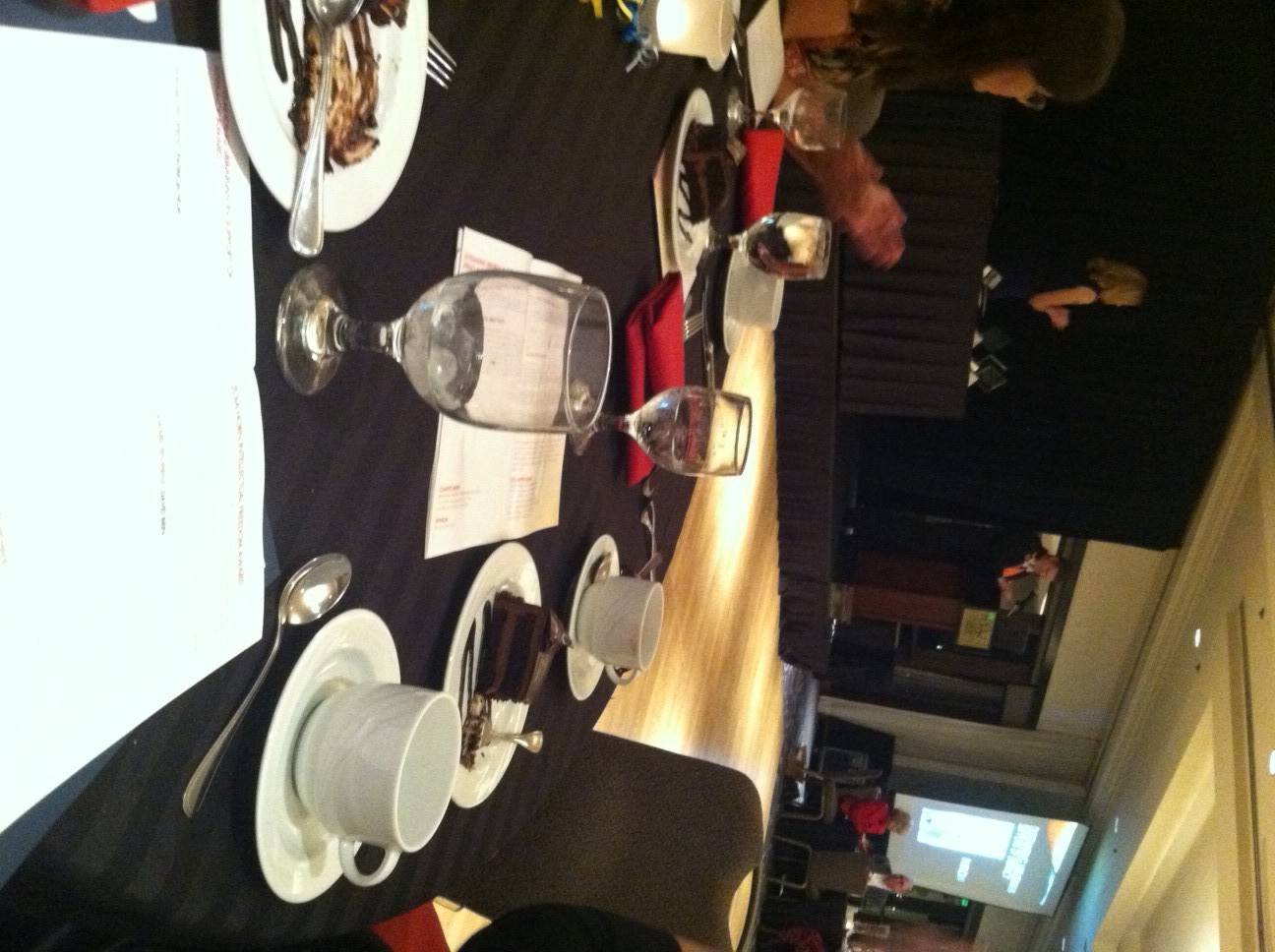
I did some livetweeting for the American Library Association Student Chapter of my time there, but I guess the actual conference is beyond the week in #HLSDITL. I can say that as a student, there is nothing better than going to conferences - use your loans to go them, get money from your school (I got money as a member of ALASC/regular session student, but look for some fundraising!). It's totally worth it to meet people face-to-face, learn about current issues in the library world, meet management and other library decision-makers, etc. I went last year and made connections that lead to a mural workshop in Oakland and saw SJSU professors who have since then become like a mentor.
I'll leave this post with a picture of the Student Interest Group, who I encourage you heartily to join if you're a CA resident/student and CLA member. I'm looking for ways to advocate for and unify CA students, so please reach out to me!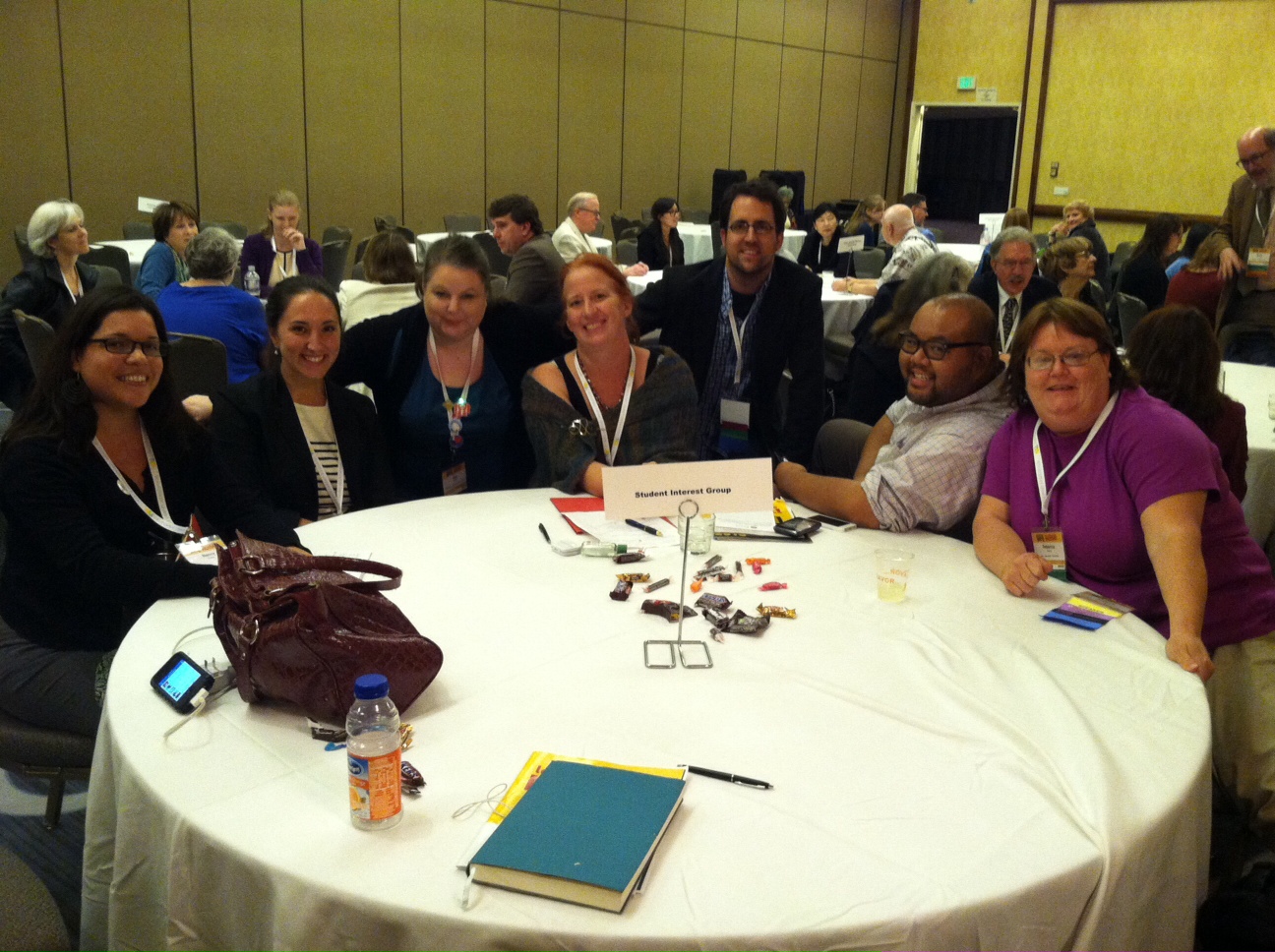
#HLSDITL Day four and five
As part of Hack Library School’s Library Student Day in the Life, a look at library students’ days around the world from October 28 – November 1, I am blogging about my week! I am a student at San Jose State University, an online program, getting my Masters in Library and Information Science. My focus is on youth librarianship. I missed yesterday! As well as a few other deadlines... what a bummer.
Yesterday I spent the morning not doing school (but made a cool moon costume), had coffee with my mom, and then biked to school like the wind. At school we saw the cute Halloween parade, I wrote up notes for the field trip I took today on makerspaces, and then I went rockclimbing and watched Ghostbusters - I wanted to review it as a tween movie, but it was not a tween movie, maybe - I didn't remember the ghost blowjob scene???
Today I went and visited two Learning Commons models at the San Francisco Friend's School and the St. Francis High School in Mountain View. A couple really interesting models; we're thinking about ways to make our library more participatory and diverse in uses. When I got home, I took care of other life things, including preparing for the conference and California Library Association board meetings. I feel perpetually behind this week, having not "been in school" for a couple days, and I'm going away this weekend. That is a bit how things are going this semester - I have troubles because I sign up for everything!
These troubles include: not making birthday cards for anyone in months, missing the deadline to change from regular to special session, and doing things with one eye on another thing. I'm in class, but I'm designing a business card. I'm reading a chapter in a textbook, but I'm also making a to-do list. I'm having coffee with my mom, but I'm also cleaning up and packing. I look forward to having a couple less things to do someday. Someday!
Tomorrow I head to LA for a CLA Board Meeting, which I am currently reading and preparing for, and I hope madly that I will be able to focus on school work on Sunday. I don't think all the madness is totally because of being an online student, but I do think it comes partly from being able to do too much. I can add another club in, because my time is structured almost completely by me. I don't have other students to keep me sane or remind me what's due, or many professors that I feel I know well enough to get their advice. This semester I have felt a bit down on the online format, especially after visiting SJSU and remembering how wonderful campuses are...

#HLSDITL, Day three!
As part of Hack Library School’s Library Student Day in the Life, a look at library students’ days around the world from October 28 – November 1, I am blogging about my week! I am a student at San Jose State University, an online program, getting my Masters in Library and Information Science. My focus is on youth librarianship. This day's theme: another day of feeling like everything is half done.
Woke up early and did some non-school related computer work and phone calls. Then, I tried to figure out if I should be a Regular or Special Session student next semester. The basic gist is, as a Regular Session student (I live in the Bay Area, am a full-time student, etc), I get access to SJSU's student services through their Associated Students (AS) and state financial aid. However, next semester SJSU has been forced to offer less electives to its Regular Session because of budget cuts, so if I want to get access to the electives I want I have to switch to Special Session. Special Session is an identical degree, except I don't get access to the AS services or funds and no state financial aid (not that they gave me any this year anyway :(!!!!). I am trying to figure out which path to take in this sad state of public university affairs!
Then I jumped on my bike to work, where I worked with one Kindergarten class, a first grade class, and 2 fourth grade classes, and then ran up to the Upper School Library for some basic tasks, and then biked home and laid in bed and read tween novels for my Materials for Tweens class (Tamora Pierce, anyone?).
After a quick dinner I had an online meeting with the American Library Association Student Chapter (ALASC) at SJSU, where I serve as the social media manager. In our meeting, we discussed a couple ideas for projects to support students and help them network. The meetings take place on Blackboard Collaborate; we use it mostly as a conference call program with a shared whiteboard. As an online meeting, there are many people on the board I have never met in person. A few of them I have met through our personal efforts or through volunteer experience. I joined the chapter so that I would widen my personal and professional relationships with other students. So far, I have wished for more in-person meet-ups, but often feel too busy!
Then I read about makerspaces and content creation in libraries, looked at the California Library Association conference website, and posted to social media for ALASC before watching Hugo (I'm reviewing it for my Materials for Tweens class). All in all, a day that left me feeling productive but behind!
Tomorrow: Halloween in the library!
#HLSDITL, Day two!
As part of Hack Library School’s Library Student Day in the Life, a look at library students’ days around the world from October 28 – November 1, I am blogging about my week! I am a student at San Jose State University, an online program, getting my Masters in Library and Information Science. My focus is on youth librarianship. Today I woke up late and had another tough day in terms of getting work done. I talked with my sister on Skype, a musician who lives in Sweden for a while, updated my website (I hadn't updated my plugins or Wordpress in a loooooong time and it was being janky, and as I'm going to the California Library Association Conference this weekend I wanted to make sure all my networking parts were working right.
Then I did some more emailing about a cool internship I'm hoping to do next semester, in which I would be working with Oakland Public Library's teen outreach librarian to do some creative programming and outreach for the Youth Poet Laureate Program. So awesome. Then I did some more emailing with a professor about meeting her at the conference for breakfast, and responded to a couple discussion board posts before going off to work.
 At work today, I was pleased to see that students had written on my participatory display about citizenship! Hurrah! So I worked to document it, talked about next steps with my supervisor, and then checked out books and shelved and prettied up the space before heading down to help out with a Kindergarten and 2nd grade class and hang up new Dewey icons I had designed to help kids find things easier in the library.
At work today, I was pleased to see that students had written on my participatory display about citizenship! Hurrah! So I worked to document it, talked about next steps with my supervisor, and then checked out books and shelved and prettied up the space before heading down to help out with a Kindergarten and 2nd grade class and hang up new Dewey icons I had designed to help kids find things easier in the library.
Then I went rock-climbing with my partner, had dinner with my dad, carved pumpkins with my neighbors, and am now settled in at 11:24 pm with some schoolwork before and after me. I posted a quick discussion post about graphic novels for my Materials for Tweens class (the questions were: Where are graphic novels shelved at your local public library? Are they in the Young Adult area, or the children's area, or both? Will Tweens find them easily? Or, are the shelved in the Dewey number (741)? Does the library have Graphic Novels for younger Tweens or just for teenagers?).
Then I turned to my Hyperlinked Library class, where I was reading about QR codes, smartphones, and storytime. All totally interesting topics: lots of information that I try to read, incorporate into what I know and what I hope to do, and try to remember. I do a lot of bookmarking and copying and pasting interesting quotes into Word documents to refer to later in discussion and blog posts.
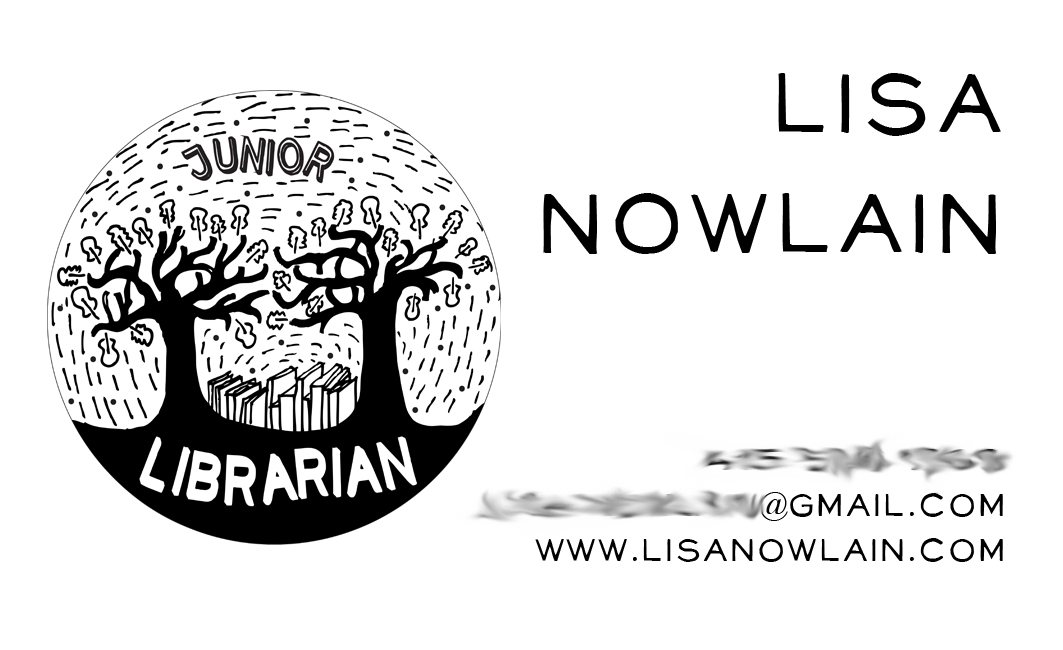 I also spent today reflecting on my meeting yesterday with my group at the Emerging Arts Professionals network. It was my first meeting in a group of artists where I was presenting myself as a librarian, and I found it incredibly refreshing. I was able to bring ideas from librarianship and school that I am totally excited about - access to free information, presented in user-friendly ways, and archived for long-term use - into a creative and inspiring setting (libraries are also creative and inspiring, but everyone expects artists to be so). I was feeling very validated in my choice to pursue librarianship, even as the Fear works its way into my heart as my graduation approaches and I hear horror stories about job hunting. I get my business cards in the mail on Halloween so I am excited to be passing those out at the conference this weekend, where I will be blogging!
I also spent today reflecting on my meeting yesterday with my group at the Emerging Arts Professionals network. It was my first meeting in a group of artists where I was presenting myself as a librarian, and I found it incredibly refreshing. I was able to bring ideas from librarianship and school that I am totally excited about - access to free information, presented in user-friendly ways, and archived for long-term use - into a creative and inspiring setting (libraries are also creative and inspiring, but everyone expects artists to be so). I was feeling very validated in my choice to pursue librarianship, even as the Fear works its way into my heart as my graduation approaches and I hear horror stories about job hunting. I get my business cards in the mail on Halloween so I am excited to be passing those out at the conference this weekend, where I will be blogging!
Tomorrow: I have a board meeting for the SJSU American Library Association Student Chapter, where I manage their social media (see Twitter, Facebook, etc), I decide if I'm going to be a Regular or Special Session student next semester.
#HLSDITL, Day one!
As part of Hack Library School's Library Student Day in the Life, a look at library students' days around the world from October 28 – November 1. I am a student at San Jose State University, an online program, getting my Masters in Library and Information Science. My focus is on youth librarianship. I am planning on graduating in May, having accelerated my pace and finishing in 2 years. This has definitely been a struggle, as I have continued to work part time, had internships, volunteered, and got married somewhere there in the middle. It's been an interesting ride: I came from out of left field into librarianship, having never worked in a library prior to entering library school. For my undergrad, I studied studio art, and spent the years after graduation doing graphic design/marketing for non-profits/my mom's small business, doing some political work, and making my own artwork, before I went to Laos on a grant and did art projects galore. What I learned there was that I love art's abilities to connect people with information and each other, and also the magical world of doing art on a grant for 9 months. When I came back to the Bay Area, I realized that I wanted to be less broke than I had been as a patcher together of odd part-time jobs and point myself in a direction that was a gratifying career, but wasn't art (I didn't want to mix art and money too much). And so, I remembered how much I loved libraries and librarians, and that libraries also connect people with information and each other, so there you go.
Long story short, this semester I am taking the Hyperlinked Library, Programming and Services for Children, Materials for Tweens, and Collection Development. I very rarely have class to attend; some of my classes have a monthly meeting or lecture, and others still have "chats" but very few of them require me to attend (I can always watch a recording). I just finished a group assignment in which we met for class, but this week is actually very free of required meetings for school.
So what I did today - after a very productive Sunday, I'm feeling pretty good about my workload this week. I have a few to-do list strategies (I really should consolidate), but generally I use an old envelope, an app called Wunderlist, and my Google Calendar to know how the week/month/day looks.
So, this morning I got up and working by 830 am, and did some school work/personal work all mixed up together:
And then I went to work, at a school library here in Oakland. Today I worked on a project in which we art trying to both use space from weeded reference books and create a more participatory (and less book-branded) library space, so I made some madlibs on windows for students to write on. Then I assisted a teacher librarian in her 1st Grade class, where I helped them find books and occasionally shushed them.
I'm also doing this thing called the Emerging Arts Professional Fellowship, where I am trying to think of ways to link arts organizations and libraries. My group, which is focusing on Open Systems, met to discuss our yearly project.
Then I helped a friend set up an Ikea bed, and here I am now making sure that tomorrow I am not missing any deadlines.
Most of what I do as an online student is try to stay on top of a pile of drifting icebergs that I think I can control, but occasionally I lose sight of one of them and it drifts away, and as a person alone in the sea I must work very hard to stay on top of my icebergs. However, I also don't commute, didn't move for school, and have had to work extra hard to make connections, which has pushed me out of being afraid of networking and into doing it like it will save me from polar bears.
Tomorrow - more school, dealing with budget cuts, plus pumpkin carving!
